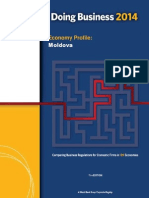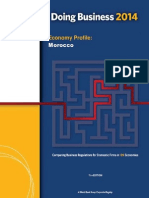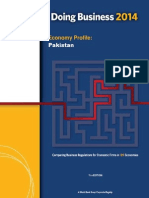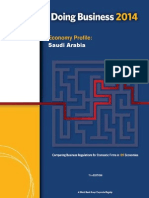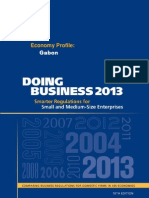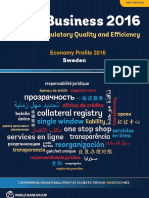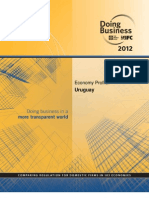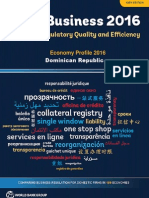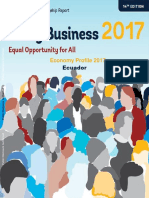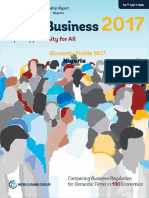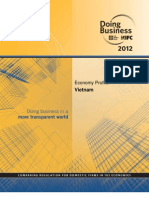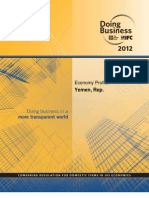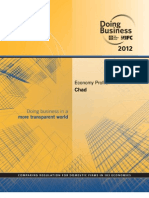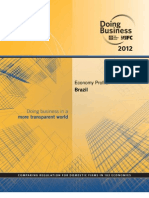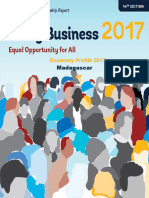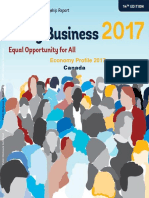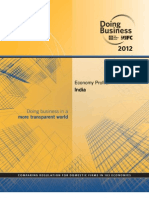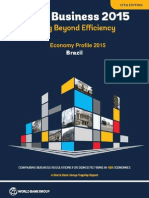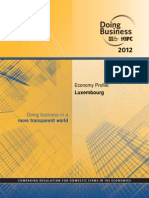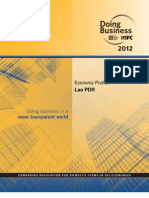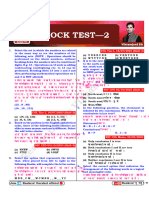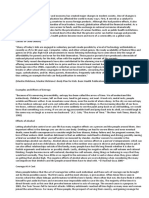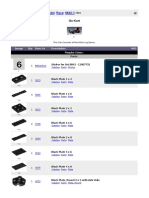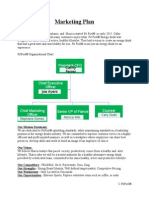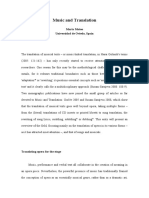Mexico
Mexico
Uploaded by
Anum HamidCopyright:
Available Formats
Mexico
Mexico
Uploaded by
Anum HamidOriginal Description:
Copyright
Available Formats
Share this document
Did you find this document useful?
Is this content inappropriate?
Copyright:
Available Formats
Mexico
Mexico
Uploaded by
Anum HamidCopyright:
Available Formats
SoEconomy
Economy Profile:
St. Mexico
2
Mexico Doing Business 2014
2013 The International Bank for Reconstruction and Development /
The World Bank
1818 H Street NW, Washington, DC 20433
Telephone: 202-473-1000; Internet: www.worldbank.org
All rights reserved.
1 2 3 4 15 14 13 12
A copublication of The World Bank and the International Finance Corporation.
This work is a product of the staff of The World Bank with external contributions.
Note that The World Bank does not necessarily own each component of the content
included in the work. The World Bank therefore does not warrant that the use of the
content contained in the work will not infringe on the rights of third parties. The risk
of claims resulting from such infringement rests solely with you.
The findings, interpretations, and conclusions expressed in this work do not
necessarily reflect the views of The World Bank, its Board of Executive Directors, or
the governments they represent. The World Bank does not guarantee the accuracy of
the data included in this work. The boundaries, colors, denominations, and other
information shown on any map in this work do not imply any judgment on the part of
The World Bank concerning the legal status of any territory or the endorsement or
acceptance of such boundaries.
Nothing herein shall constitute or be considered to be a limitation upon or waiver of
the privileges and immunities of The World Bank, all of which are specifically
reserved.
Rights and Permissions
This work is available under the Creative Commons Attribution 3.0
Unported license (CC BY 3.0)
http://creativecommons.org/licenses/by/3.0. Under the Creative
Commons Attribution license, you are free to copy, distribute, transmit, and adapt
this work, including for commercial purposes, under the following conditions:
AttributionPlease cite the work as follows: World Bank. 2013. Doing Business 2014:
Understanding Regulations for Small and Medium-Size Enterprises. Washington, DC:
World Bank Group. DOI: 10.1596/978-0-8213-9615-5. License: Creative Commons
Attribution CC BY 3.0
TranslationsIf you create a translation of this work, please add the following
disclaimer along with the attribution: This translation was not created by The World
Bank and should not be considered an official World Bank translation. The World Bank
shall not be liable for any content or error in this translation.
All queries on rights and licenses should be addressed to the Office of the Publisher,
The World Bank, 1818 H Street NW, Washington, DC 20433, USA; fax: 202-522-2625;
e-mail: pubrights@worldbank.org.
Additional copies of all 11 editions of Doing Business may be purchased at
www.doingbusiness.org.
Cover design: The Word Express
3
Mexico Doing Business 2014
CONTENTS
Introduction .................................................................................................................................. 4
The business environment .......................................................................................................... 5
Starting a business ..................................................................................................................... 14
Dealing with construction permits ........................................................................................... 23
Getting electricity ....................................................................................................................... 33
Registering property .................................................................................................................. 41
Getting credit .............................................................................................................................. 54
Protecting investors ................................................................................................................... 61
Paying taxes ................................................................................................................................ 70
Trading across borders .............................................................................................................. 77
Enforcing contracts .................................................................................................................... 85
Resolving insolvency .................................................................................................................. 95
Employing workers .................................................................................................................. 100
Data notes ................................................................................................................................. 107
Resources on the Doing Business website ............................................................................ 113
4
Mexico Doing Business 2014
INTRODUCTION
Doing Business sheds light on how easy or difficult it is
for a local entrepreneur to open and run a small to
medium-size business when complying with relevant
regulations. It measures and tracks changes in
regulations affecting 11 areas in the life cycle of a
business: starting a business, dealing with construction
permits, getting electricity, registering property,
getting credit, protecting investors, paying taxes,
trading across borders, enforcing contracts, resolving
insolvency and employing workers.
In a series of annual reports Doing Business presents
quantitative indicators on business regulations and the
protection of property rights that can be compared
across 189 economies, from Afghanistan to Zimbabwe,
over time. The data set covers 47 economies in Sub-
Saharan Africa, 33 in Latin America and the Caribbean,
25 in East Asia and the Pacific, 25 in Eastern Europe
and Central Asia, 20 in the Middle East and North
Africa and 8 in South Asia, as well as 31 OECD high-
income economies. The indicators are used to analyze
economic outcomes and identify what reforms have
worked, where and why.
This economy profile presents the Doing Business
indicators for Mexico. To allow useful comparison, it
also provides data for other selected economies
(comparator economies) for each indicator. The data in
this report are current as of June 1, 2013 (except for
the paying taxes indicators, which cover the period
JanuaryDecember 2012).
The Doing Business methodology has limitations. Other
areas important to businesssuch as an economys
proximity to large markets, the quality of its
infrastructure services (other than those related to
trading across borders and getting electricity), the
security of property from theft and looting, the
transparency of government procurement,
macroeconomic conditions or the underlying strength
of institutionsare not directly studied by Doing
Business. The indicators refer to a specific type of
business, generally a local limited liability company
operating in the largest business city. Because
standard assumptions are used in the data collection,
comparisons and benchmarks are valid across
economies. The data not only highlight the extent of
obstacles to doing business; they also help identify the
source of those obstacles, supporting policy makers in
designing regulatory reform.
More information is available in the full report. Doing
Business 2014 presents the indicators, analyzes their
relationship with economic outcomes and presents
business regulatory reforms. The data, along with
information on ordering Doing Business 2014, are
available on the Doing Business website at
http://www.doingbusiness.org.
5
Mexico Doing Business 2014
THE BUSINESS ENVIRONMENT
For policy makers trying to improve their economys
regulatory environment for business, a good place to
start is to find out how it compares with the regulatory
environment in other economies. Doing Business
provides an aggregate ranking on the ease of doing
business based on indicator sets that measure and
benchmark regulations applying to domestic small to
medium-size businesses through their life cycle.
Economies are ranked from 1 to 189 by the ease of
doing business index. For each economy the index is
calculated as the ranking on the simple average of its
percentile rankings on each of the 10 topics included in
the index in Doing Business 2014: starting a business,
dealing with construction permits, getting electricity,
registering property, getting credit, protecting
investors, paying taxes, trading across borders,
enforcing contracts and resolving insolvency. The
ranking on each topic is the simple average of the
percentile rankings on its component indicators (see
the data notes for more details). The employing workers
indicators are not included in this years aggregate ease
of doing business ranking, but the data are presented
in this years economy profile.
The aggregate ranking on the ease of doing business
benchmarks each economys performance on the
indicators against that of all other economies in the
Doing Business sample (figure 1.1). While this ranking
tells much about the business environment in an
economy, it does not tell the whole story. The ranking on
the ease of doing business, and the underlying
indicators, do not measure all aspects of the business
environment that matter to firms and investors or that
affect the competitiveness of the economy. Still, a high
ranking does mean that the government has created a
regulatory environment conducive to operating a
business.
ECONOMY OVERVIEW
Region: Latin America & Caribbean
Income category: Upper middle income
Population: 120,847,477
GNI per capita (US$): 9,740
DB2014 rank: 53
DB2013 rank: 51*
Change in rank: -2
DB 2014 DTF: 70.89
DB 2013 DTF: 70.66
Change in DTF: 0.19
* DB2013 ranking shown is not last years published
ranking but a comparable ranking for DB2013 that
captures the effects of such factors as data
corrections and the addition of 4 economies (Libya,
Myanmar, San Marino and South Sudan) to the
sample this year. See the data notes for sources and
definitions.
6
Mexico Doing Business 2014
THE BUSINESS ENVIRONMENT
Figure 1.1 Where economies stand in the global ranking on the ease of doing business
Source: Doing Business database.
7
Mexico Doing Business 2014
THE BUSINESS ENVIRONMENT
For policy makers, knowing where their economy
stands in the aggregate ranking on the ease of
doing business is useful. Also useful is to know how
it ranks relative to comparator economies and
relative to the regional average (figure 1.2). The
economys rankings on the topics included in the
ease of doing business index provide another
perspective (figure 1.3).
Figure 1.2 How Mexico and comparator economies rank on the ease of doing business
Source: Doing Business database.
8
Mexico Doing Business 2014
THE BUSINESS ENVIRONMENT
Figure 1.3 How Mexico ranks on Doing Business topics
Source: Doing Business database.
9
Mexico Doing Business 2014
THE BUSINESS ENVIRONMENT
Just as the overall ranking on the ease of doing business
tells only part of the story, so do changes in that ranking.
Yearly movements in rankings can provide some indication
of changes in an economys regulatory environment for
firms, but they are always relative.
Moreover, year-to-year changes in the overall rankings do
not reflect how the business regulatory environment in an
economy has changed over timeor how it has changed
in different areas. To aid in assessing such changes,
Doing Business introduced the distance to frontier
measure. This measure shows how far on average an
economy is from the best performance achieved by any
economy on each Doing Business indicator since 2005,
except for the getting electricity indicators, which were
introduced in 2009.
Comparing the measure for an economy at 2 points in
time allows users to assess how much the economys
regulatory environment as measured by Doing Business
has changed over timehow far it has moved toward (or
away from) the most efficient practices and strongest
regulations in areas covered by Doing Business (figure 1.4).
Figure 1.4 How far has Mexico come in the areas measured by Doing Business?
Note: The distance to frontier measure shows how far on average an economy is from the best performance achieved by any
economy on each Doing Business indicator since 2005, except for the getting electricity indicators, which were introduced in 2009. The
measure is normalized to range between 0 and 100, with 100 representing the best performance (the frontier). The overall distance to
frontier is the average of the distance to frontier in the first 9 indicator sets shown in the figure and does not include getting
electricity. Data on the overall distance to frontier including getting electricity is available at
http://www.doingbusiness.org/data/distance-to-frontier. See the data notes for more details on the distance to frontier measure.
Source: Doing Business database.
10
Mexico Doing Business 2014
THE BUSINESS ENVIRONMENT
The absolute values of the indicators tell another part
of the story (table 1.1). The indicators, on their own or
in comparison with the indicators of a good practice
economy or those of comparator economies in the
region, may reveal bottlenecks reflected in large
numbers of procedures, long delays or high costs. Or
they may reveal unexpected strengths in an area of
business regulationsuch as a regulatory process that
can be completed with a small number of procedures
in a few days and at a low cost. Comparison of the
economys indicators today with those in the previous
year may show where substantial bottlenecks persist
and where they are diminishing.
Table 1.1 Summary of Doing Business indicators for Mexico
Indicator
M
e
x
i
c
o
D
B
2
0
1
4
M
e
x
i
c
o
D
B
2
0
1
3
A
r
g
e
n
t
i
n
a
D
B
2
0
1
4
B
r
a
z
i
l
D
B
2
0
1
4
C
h
i
l
e
D
B
2
0
1
4
C
h
i
n
a
D
B
2
0
1
4
C
o
l
o
m
b
i
a
D
B
2
0
1
4
I
n
d
i
a
D
B
2
0
1
4
B
e
s
t
p
e
r
f
o
r
m
e
r
g
l
o
b
a
l
l
y
D
B
2
0
1
4
Starting a Business
(rank)
48 41 164 123 22 158 79 179 New Zealand (1)
Procedures (number) 6 6 14 13 7 13 9 12 New Zealand (1)*
Time (days) 6.0 6.0 25.0 107.5 5.5 33.0 15.0 27.0 New Zealand (0.5)
Cost (% of income per
capita)
19.7 20.0 19.9 4.6 0.7 2.0 7.5 47.3 Slovenia (0.0)
Paid-in Min. Capital (%
of income per capita)
0.0 0.0 5.7 0.0 0.0 78.2 0.0 124.4 112 Economies (0.0)*
Dealing with
Construction Permits
(rank)
40 41 181 130 101 185 24 182
Hong Kong SAR,
China (1)
Procedures (number) 11 11 24 15 15 25 8 35
Hong Kong SAR,
China (6)
Time (days) 82.0 82.0 365.0 400.0 155.0 270.0 54.0 168.0 Singapore (26.0)
11
Mexico Doing Business 2014
Indicator
M
e
x
i
c
o
D
B
2
0
1
4
M
e
x
i
c
o
D
B
2
0
1
3
A
r
g
e
n
t
i
n
a
D
B
2
0
1
4
B
r
a
z
i
l
D
B
2
0
1
4
C
h
i
l
e
D
B
2
0
1
4
C
h
i
n
a
D
B
2
0
1
4
C
o
l
o
m
b
i
a
D
B
2
0
1
4
I
n
d
i
a
D
B
2
0
1
4
B
e
s
t
p
e
r
f
o
r
m
e
r
g
l
o
b
a
l
l
y
D
B
2
0
1
4
Cost (% of income per
capita)
353.1 322.7 234.1 34.8 69.9 344.7 295.4 2,640.4 Qatar (1.1)
Getting Electricity
(rank)
133 133 80 14 43 119 101 111 Iceland (1)
Procedures (number) 7 7 6 4 6 5 5 7 10 Economies (3)*
Time (days) 85 95 91 58 30 145 105 67 Germany (17)
Cost (% of income per
capita)
369.1 382.8 40.3 34.4 63.9 499.2 541.6 230.7 Japan (0.0)
Registering Property
(rank)
150 145 138 107 55 48 53 92 Georgia (1)
Procedures (number) 7 7 7 14 6 4 7 5 4 Economies (1)*
Time (days) 74.0 74.0 53.5 30.0 28.5 29.0 13.0 44.0 New Zealand (1.0)*
Cost (% of property
value)
5.3 5.3 6.6 2.6 1.2 3.6 2.0 7.0 5 Economies (0.0)*
Getting Credit (rank) 42 40 73 109 55 73 73 28 Malaysia (1)*
Strength of legal rights
index (0-10)
6 6 4 3 6 5 5 8 10 Economies (10)*
Depth of credit
information index (0-6)
6 6 6 5 5 5 5 5 31 Economies (6)*
Public registry coverage
(% of adults)
0.0 0.0 41.9 50.4 40.5 30.2 0.0 0.0 Portugal (100.0)*
Private bureau
coverage (% of adults)
100.0 99.2 100.0 63.4 5.9 0.0 83.8 19.8 22 Economies (100.0)*
Protecting Investors
(rank)
68 67 98 80 34 98 6 34 New Zealand (1)
Extent of disclosure
8 8 7 5 8 10 9 7 10 Economies (10)*
12
Mexico Doing Business 2014
Indicator
M
e
x
i
c
o
D
B
2
0
1
4
M
e
x
i
c
o
D
B
2
0
1
3
A
r
g
e
n
t
i
n
a
D
B
2
0
1
4
B
r
a
z
i
l
D
B
2
0
1
4
C
h
i
l
e
D
B
2
0
1
4
C
h
i
n
a
D
B
2
0
1
4
C
o
l
o
m
b
i
a
D
B
2
0
1
4
I
n
d
i
a
D
B
2
0
1
4
B
e
s
t
p
e
r
f
o
r
m
e
r
g
l
o
b
a
l
l
y
D
B
2
0
1
4
index (0-10)
Extent of director
liability index (0-10)
5 5 2 8 6 1 8 4 Cambodia (10)
Ease of shareholder
suits index (0-10)
4 4 6 3 5 4 8 8 3 Economies (10)*
Strength of investor
protection index (0-10)
5.7 5.7 5.0 5.3 6.3 5.0 8.3 6.3 New Zealand (9.7)
Paying Taxes (rank) 118 114 153 159 38 120 104 158
United Arab Emirates
(1)
Payments (number per
year)
6 6 9 9 7 7 10 33
Hong Kong SAR,
China (3)*
Time (hours per year) 334 337 405 2,600 291 318 203 243
United Arab Emirates
(12)
Trading Across Borders
(rank)
59 63 129 124 40 74 94 132 Singapore (1)
Documents to export
(number)
4 4 6 6 5 8 4 9 Ireland (2)*
Time to export (days) 11 12 12 13 15 21 14 16 5 Economies (6)*
Cost to export (US$ per
container)
1,450 1,450 1,650 2,215 980 620 2,355 1,170 Malaysia (450)
Documents to import
(number)
4 4 8 8 5 5 6 11 Ireland (2)*
Time to import (days) 11 12 30 17 12 24 13 20 Singapore (4)
Cost to import (US$ per
container)
1,740 1,780 2,260 2,275 930 615 2,470 1,250 Singapore (440)
Enforcing Contracts
(rank)
71 73 57 121 64 19 155 186 Luxembourg (1)
13
Mexico Doing Business 2014
Indicator
M
e
x
i
c
o
D
B
2
0
1
4
M
e
x
i
c
o
D
B
2
0
1
3
A
r
g
e
n
t
i
n
a
D
B
2
0
1
4
B
r
a
z
i
l
D
B
2
0
1
4
C
h
i
l
e
D
B
2
0
1
4
C
h
i
n
a
D
B
2
0
1
4
C
o
l
o
m
b
i
a
D
B
2
0
1
4
I
n
d
i
a
D
B
2
0
1
4
B
e
s
t
p
e
r
f
o
r
m
e
r
g
l
o
b
a
l
l
y
D
B
2
0
1
4
Time (days) 400 415 590 731 480 406 1,288 1,420 Singapore (150)
Cost (% of claim) 31.0 31.0 20.5 16.5 28.6 11.1 47.9 39.6 Bhutan (0.1)
Procedures (number) 38 38 36 44 36 37 34 46 Singapore (21)*
Resolving Insolvency
(rank)
26 26 97 135 102 78 25 121 Japan (1)
Time (years) 1.8 1.8 2.8 4.0 3.2 1.7 1.7 4.3 Ireland (0.4)
Cost (% of estate) 18 18 12 12 15 22 6 9 Norway (1)
Outcome (0 as
piecemeal sale and 1 as
going concern)
1 1 0 1 0 0 1 0
Recovery rate (cents on
the dollar)
67.6 67.3 30.8 19.5 29.1 36.0 70.3 25.6 Japan (92.8)
Note: DB2013 rankings shown are not last years published rankings but comparable rankings for DB2013 that capture the effects of
such factors as data corrections and the addition of 4 economies (Libya, Myanmar, San Marino and South Sudan) to the sample this
year. For more information on no practice marks, see the data notes.
* Two or more economies share the top ranking on this indicator. A number shown in place of an economys name indicates the
number of economies that share the top ranking on the indicator. For a list of these economies, see the Doing Business website
(http://www.doingbusiness.org).
Source: Doing Business database.
14
Mexico Doing Business 2014
STARTING A BUSINESS
Formal registration of companies has many
immediate benefits for the companies and for
business owners and employees. Legal entities can
outlive their founders. Resources are pooled as
several shareholders join forces to start a company.
Formally registered companies have access to
services and institutions from courts to banks as
well as to new markets. And their employees can
benefit from protections provided by the law. An
additional benefit comes with limited liability
companies. These limit the financial liability of
company owners to their investments, so personal
assets of the owners are not put at risk. Where
governments make registration easy, more
entrepreneurs start businesses in the formal sector,
creating more good jobs and generating more
revenue for the government.
What do the indicators cover?
Doing Business measures the ease of starting a
business in an economy by recording all
procedures officially required or commonly done in
practice by an entrepreneur to start up and
formally operate an industrial or commercial
businessas well as the time and cost required to
complete these procedures. It also records the
paid-in minimum capital that companies must
deposit before registration (or within 3 months).
The ranking on the ease of starting a business is
the simple average of the percentile rankings on
the 4 component indicators: procedures, time, cost
and paid-in minimum capital requirement.
To make the data comparable across economies,
Doing Business uses several assumptions about the
business and the procedures. It assumes that all
information is readily available to the entrepreneur
and that there has been no prior contact with
officials. It also assumes that the entrepreneur will
pay no bribes. And it assumes that the business:
Is a limited liability company, located in the
largest business city and is 100% domestically
owned.
Has between 10 and 50 employees.
Conducts general commercial or industrial
activities.
WHAT THE STARTING A BUSINESS
INDICATORS MEASURE
Procedures to legally start and operate a
company (number)
Preregistration (for example, name
verification or reservation, notarization)
Registration in the economys largest
business city
Postregistration (for example, social security
registration, company seal)
Time required to complete each procedure
(calendar days)
Does not include time spent gathering
information
Each procedure starts on a separate day (2
procedures cannot start on the same day).
Procedures that can be fully completed
online are an exception to this rule.
Procedure completed once final document is
received
No prior contact with officials
Cost required to complete each procedure
(% of income per capita)
Official costs only, no bribes
No professional fees unless services required
by law
Paid-in minimum capital (% of income
per capita)
Deposited in a bank or with a notary before
registration (or within 3 months)
Has a start-up capital of 10 times income per
capita.
Has a turnover of at least 100 times income per
capita.
Does not qualify for any special benefits.
Does not own real estate.
15
Mexico Doing Business 2014
STARTING A BUSINESS
Where does the economy stand today?
What does it take to start a business in Mexico?
According to data collected by Doing Business, starting
a business there requires 6 procedures, takes 6.0 days,
costs 19.7% of income per capita and requires paid-in
minimum capital of 0.0% of income per capita (figure
2.1).
Figure 2.1 What it takes to start a business in Mexico
Paid-in minimum capital (% of income per capita): 0.0
Note: Time shown in the figure above may not reflect simultaneity of procedures. Online procedures account for 0.5 days in the
total time calculation. For more information on the methodology of the starting a business indicators, see the Doing Business
website (http://www.doingbusiness.org). For details on the procedures reflected here, see the summary at the end of this
chapter.
Source: Doing Business database.
16
Mexico Doing Business 2014
STARTING A BUSINESS
Globally, Mexico stands at 48 in the ranking of 189
economies on the ease of starting a business (figure
2.2). The rankings for comparator economies and the
regional average ranking provide other useful
information for assessing how easy it is for an
entrepreneur in Mexico to start a business.
Figure 2.2 How Mexico and comparator economies rank on the ease of starting a business
Source: Doing Business database.
17
Mexico Doing Business 2014
STARTING A BUSINESS
What are the changes over time?
The benchmarks provided by the economies that over
time have had the best performance regionally or
globally on the procedures, time, cost or paid-in
minimum capital required to start a business (figure
2.3) can help show what is possible in making it easier
to start a business. And changes in regional averages
can show where Mexico is keeping upand where it is
falling behind.
Figure 2.3 Has starting a business become easier over time?
Procedures (number)
Time (days)
18
Mexico Doing Business 2014
STARTING A BUSINESS
Cost (% of income per capita)
Paid-in minimum capital (% of income per capita)
Note: Ninety economies globally have no paid-in minimum capital requirement. DB2013 rankings shown are not last years
published rankings but comparable rankings for DB2013 that capture the effects of such factors as data corrections and
the addition of 4 economies (Libya, Myanmar, San Marino and South Sudan) to the sample this year.
Source: Doing Business database.
19
Mexico Doing Business 2014
STARTING A BUSINESS
Economies around the world have taken steps making
it easier to start a businessstreamlining procedures
by setting up a one-stop shop, making procedures
simpler or faster by introducing technology and
reducing or eliminating minimum capital requirements.
Many have undertaken business registration reforms in
stagesand they often are part of a larger regulatory
reform program. Among the benefits have been
greater firm satisfaction and savings and more
registered businesses, financial resources and job
opportunities.
What business registration reforms has Doing Business
recorded in Mexico (table 2.1)?
Table 2.1 How has Mexico made starting a business easieror not?
By Doing Business report year
DB year
Reform
DB2009 No reform as measured by Doing Business.
DB2010
Mexico eased the business start-up process by establishing an
electronic platform for company registration, reducing the
number of days for registration substantially, and by removing
the requirement to register with the statistical office.
DB2011
Mexico launched an online one-stop shop for initiating
business registration.
DB2012 No reform as measured by Doing Business.
DB2013
Mexico made starting a business easier by eliminating the
minimum capital requirement for limited liability companies.
DB2014 No reform as measured by Doing Business.
Note: For information on reforms in earlier years (back to DB2005), see the Doing Business reports
for these years, available at http://www.doingbusiness.org.
Source: Doing Business database.
20
Mexico Doing Business 2014
STARTING A BUSINESS
What are the details?
Underlying the indicators shown in this chapter for
Mexico is a set of specific proceduresthe
bureaucratic and legal steps that an entrepreneur
must complete to incorporate and register a new
firm. These are identified by Doing Business
through collaboration with relevant local
professionals and the study of laws, regulations and
publicly available information on business entry in
that economy. Following is a detailed summary of
those procedures, along with the associated time
and cost. These procedures are those that apply to
a company matching the standard assumptions
(the standardized company) used by Doing
Business in collecting the data (see the section in
this chapter on what the indicators measure).
STANDARDIZED COMPANY
City: Mexico City
Legal Form: Sociedad Annima (S.A.) -
Corporation
Paid in Minimum Capital Requirement: None
Start-up Capital: 10 times GNI per capita
Summary of procedures for starting a business in Mexicoand the time and cost
No. Procedure
Time to
complete
Cost to complete
1
Obtain the authorization of using the company name online and
file the draft deed of incorporation with the notary online
The applicant can obtain authorization of using the company name
online from the following website www.tuempresa.gob.mx. After the
name is reserved, the entrepreneur can choose the notary public that
will grant the deed of incorporation and then file the draft deed of
incorporation online to the notary. The notary informs the entrepreneur
by email of the appointment date to sign the deed of incorporation.
This request is then filed before the Ministry of Economy, who has three
business days to determine if that name may be authorized.
Procedure can be done online
Less than one day
(online procedure)
no charge
2
Sign the deed of incorporation before a notary public, obtain Tax
Registry Number (RFC) and file online the deed of incorporation
with the Public Register of Commerce
If the notary public drafts or provides expert advice on the company
bylaws, notary fees are generally high, from MXN 5,000 to MXN 11,000.
The company charter and bylaws must be drafted before appearing
before a notary public.
Certain notaries in Mexico City have signed an agreement with the
Ministry of Finance and Public Credit (Secretara de Hacienda y Crdito
Pblico) (through the Sistema de Administracin Tributaria, SAT) to
grant the tax registration number. The notary who issues the tax
registration number must also issue the deed of incorporation. The
notary files the notarized deed of incorporation with the Public Registry
of Commerce through the online portal - tuempresa.gob.mx - and
obtain the tax number online as well.
2-3 days
MXN 10,500 (notary
fees)+ MXN 14341
(registration fees)
21
Mexico Doing Business 2014
No. Procedure
Time to
complete
Cost to complete
It usually takes the notary 2-3 days to review the documents and
process the final incorporation deed for execution by the relevant
parties.
3
Register with the Mexican Social Security Institute (IMSS)
The company must register with the Mexican Social Security Institute
(IMSS) and the National Workers Housing Fund Institute (INFONAVIT)
and open individual retirement savings accounts for employees. The
registration is conducted before the IMSS delegation (delegacin) in
the companys jurisdiction.
1 day no charge
4
Register with the local tax administration (Secretara de Finanzas
del Gobierno del Distrito Federal) for payroll tax
The company must register with the local tax administration after
registering with the IMSS. The local office can be found at
www.finanzas.df.gob.mx. The tax registration number and the
companys postal code are required to register.
1 day no charge
5
Notify the local government (Delegacin) online of the opening of
a mercantile establishment.
The notice of opening a mercantile establishment is fully completed
online through the website www.sedeco.df.gob.mx. For low risk
activities, the notification record is received automatically in an email.
Procedure can be done online
Less than one day
(online procedure)
no charge
6
Register with the National Business Information Registry (Sistema
de Information Empresarial, SIEM)
Mandatory registration with the National Business Information Registry
(Sistema de Information Empresarial, SIEM) has been in effect since
January 1997. The company will be registered with the specific chamber
corresponding to its corporate purpose or activities. The cost varies
with the number of employees and the companys activities as shown
below.
Fees for industry related activities (maximum fees)
-6 or more employees $ 670
-3 to 5 employees $ 350
-Up to 2 employees $ 150
Fees for commercial and services related activities (maximum fees)
-4 or more employees $ 640
-3 or less employees $ 300
-Up to 2 employees $ 100
The costs can vary from MXN $100 to MXN $670
1 day
The costs can vary
from MXN $100 to
MXN $670
22
Mexico Doing Business 2014
No. Procedure
Time to
complete
Cost to complete
* Takes place simultaneously with another procedure.
Note: Online procedures account for 0.5 days in the total time calculation.
Source: Doing Business database.
23
Mexico Doing Business 2014
DEALING WITH CONSTRUCTION PERMITS
Regulation of construction is critical to protect the
public. But it needs to be efficient, to avoid
excessive constraints on a sector that plays an
important part in every economy. Where complying
with building regulations is excessively costly in
time and money, many builders opt out. They may
pay bribes to pass inspections or simply build
illegally, leading to hazardous construction that
puts public safety at risk. Where compliance is
simple, straightforward and inexpensive, everyone
is better off.
What do the indicators cover?
Doing Business records the procedures, time and
cost for a business in the construction industry to
obtain all the necessary approvals to build a
warehouse in the economys largest business city,
connect it to basic utilities and register the
property so that it can be used as collateral or
transferred to another entity.
The ranking on the ease of dealing with
construction permits is the simple average of the
percentile rankings on its component indicators:
procedures, time and cost.
To make the data comparable across economies,
Doing Business uses several assumptions about the
business and the warehouse, including the utility
connections.
The business:
Is a limited liability company operating in
the construction business and located in
the largest business city.
Is domestically owned and operated.
Has 60 builders and other employees.
The warehouse:
Is a new construction (there was no
previous construction on the land).
Has complete architectural and technical
plans prepared by a licensed architect or
engineer.
WHAT THE DEALING WITH CONSTRUCTION
PERMITS INDICATORS MEASURE
Procedures to legally build a warehouse
(number)
Submitting all relevant documents and
obtaining all necessary clearances, licenses,
permits and certificates
Submitting all required notifications and
receiving all necessary inspections
Obtaining utility connections for water,
sewerage and a land telephone line
Registering the warehouse after its
completion (if required for use as collateral or
for transfer of the warehouse)
Time required to complete each procedure
(calendar days)
Does not include time spent gathering
information
Each procedure starts on a separate day.
Procedures that can be fully completed online
are an exception to this rule.
Procedure considered completed once final
document is received
No prior contact with officials
Cost required to complete each procedure (%
of income per capita)
Official costs only, no bribes
Will be connected to water, sewerage
(sewage system, septic tank or their
equivalent) and a fixed telephone line. The
connection to each utility network will be 10
meters (32 feet, 10 inches) long.
Will be used for general storage, such as of
books or stationery (not for goods requiring
special conditions).
Will take 30 weeks to construct (excluding all
delays due to administrative and regulatory
requirements).
24
Mexico Doing Business 2014
DEALING WITH CONSTRUCTION PERMITS
Where does the economy stand today?
What does it take to comply with the formalities to
build a warehouse in Mexico? According to data
collected by Doing Business, dealing with construction
permits there requires 11 procedures, takes 82.0 days
and costs 353.1% of income per capita (figure 3.1).
Figure 3.1 What it takes to comply with formalities to build a warehouse in Mexico
Note: Time shown in the figure above may not reflect simultaneity of procedures. Online procedures account for 0.5 days in the
total time calculation. For more information on the methodology of the dealing with construction permits indicators, see the
Doing Business website (http://www.doingbusiness.org). For details on the procedures reflected here, see the summary at the
end of this chapter.
Source: Doing Business database.
25
Mexico Doing Business 2014
DEALING WITH CONSTRUCTION PERMITS
Globally, Mexico stands at 40 in the ranking of 189
economies on the ease of dealing with construction
permits (figure 3.2). The rankings for comparator
economies and the regional average ranking provide
other useful information for assessing how easy it is for
an entrepreneur in Mexico to legally build a
warehouse.
Figure 3.2 How Mexico and comparator economies rank on the ease of dealing with construction permits
Source: Doing Business database.
26
Mexico Doing Business 2014
DEALING WITH CONSTRUCTION PERMITS
What are the changes over time?
The benchmarks provided by the economies that over
time have had the best performance regionally or
globally on the procedures, time or cost required to
deal with construction permits (figure 3.3) help show
what is possible in making it easier to deal with
construction permits. And changes in regional
averages can show where Mexico is keeping upand
where it is falling behind.
Figure 3.3 Has dealing with construction permits become easier over time?
Procedures (number)
Time (days)
27
Mexico Doing Business 2014
DEALING WITH CONSTRUCTION PERMITS
Cost (% of income per capita)
Note: DB2013 rankings shown are not last years published rankings but comparable rankings for DB2013 that capture the
effects of such factors as data corrections and the addition of 4 economies (Libya, Myanmar, San Marino and South Sudan) to
the sample this year. For more information on no practice marks, see the data notes.
Source: Doing Business database.
28
Mexico Doing Business 2014
DEALING WITH CONSTRUCTION PERMITS
Smart regulation ensures that standards are met while
making compliance easy and accessible to all.
Coherent and transparent rules, efficient processes and
adequate allocation of resources are especially
important in sectors where safety is at stake.
Construction is one of them. In an effort to ensure
building safety while keeping compliance costs
reasonable, governments around the world have
worked on consolidating permitting requirements.
What construction permitting reforms has Doing
Business recorded in Mexico (table 3.1)?
Table 3.1 How has Mexico made dealing with construction permits easieror not?
By Doing Business report year
DB year Reform
DB2009 No reform as measured by Doing Business.
DB2010 No reform as measured by Doing Business.
DB2011
Mexico improved construction permitting by merging and
streamlining procedures related to zoning and utilities.
DB2012
Mexico made dealing with construction permits faster by
consolidating internal administrative procedures.
DB2013 No reform as measured by Doing Business.
DB2014 No reform as measured by Doing Business.
Note: For information on reforms in earlier years (back to DB2006), see the Doing Business reports
for these years, available at http://www.doingbusiness.org.
Source: Doing Business database.
29
Mexico Doing Business 2014
DEALING WITH CONSTRUCTION PERMITS
What are the details?
The indicators reported here for Mexico are based
on a set of specific proceduresthe steps that a
company must complete to legally build a
warehouseidentified by Doing Business through
information collected from experts in construction
licensing, including architects, civil engineers,
construction lawyers, construction firms, utility
service providers and public officials who deal with
building regulations. These procedures are those
that apply to a company and structure matching
the standard assumptions used by Doing Business
in collecting the data (see the section in this
chapter on what the indicators cover).
BUILDING A WAREHOUSE
City : Mexico City
Estimated
Warehouse Value :
MXN 2,796,270
The procedures, along with the associated time and
cost, are summarized below.
Summary of procedures for dealing with construction permits in Mexico and the time and cost
No. Procedure
Time to
complete
Cost to complete
1
Request and obtain the alignment certificate (alineamiento) and
official number (nmero official)
The relevant agencies for this procedure are the Delegational One-Stop
Shop (Ventanilla nica Delegacional), the Urban Development and
Housing Ministry (Secretara de Desarrollo Urbano y Vivienda), and the
Federal District Department (Gobierno del Distrito Federal). Either a
simple original copy or a certified one is acceptable.
For the official number, the Federal District Department will assign, at
the request of the interested party, a single official number for each
property that has a front facing the public pathway. For the official
alignment: The plot across the land indicates the restrictions or
expropriation lines to be respected in the interaction between the
property and the public pathway. Obtaining the single zoning
certificate stating specific land use and feasibility is required.
Requirements:
Proof of payment of applicable real estate taxes (copy)
Public deed certifying property or title ownership (original and copy)
Payment of all fees
Application form (original)
Identification of the person completing the procedure and document
certifying the respective identity (original and copy)
Payment is made the same day when the certificate is requested. At the
same time, a date is set for the taxpayer to return to receive the
certificate, generally within 3 or 4 working days. The certificate is valid
for 2 years.
The cost is established by the Financial Code of the Federal District,
Articles 233 and 234: The official cost, as amended in January 2012 is
11 days MXN 1,001
30
Mexico Doing Business 2014
No. Procedure
Time to
complete
Cost to complete
the sum of the alignment at MXN 33.00 per linear meter of the front of
the building plus a general fee for the official number at MXN 215.50.
In this case, the front of building is assumed to be 22.5 meters, so the
total cost would be MXN 958.00.
The official time limit is 8 days, but in practice, the process can take 1 --
2 weeks.
2
Request and obtain single zoning certificate stating specific land
use
At this stage, BuildCo obtains the document that certifies whether a
specific use of a given building is authorized. This certificate reflects the
technical opinion of the competent administrative units.
The Financial Code of the Federal District, Article 235, Section V, was
amended in January 2012.
12 days MXN 892
3
Request and obtain water feasibility study
12 days no charge
4
Register Construction Statement Type B
Construction Statement Type B applies to nonresidential or mixed uses
of up to 5,000 square meters or up to 10,000 square meters for
residential use or for single-family dwelling units within a risk zone.
Requirements:
Valid alignment certificate and official number (simple original copy
or certified one)
Single zoning certificate for specific land use and feasibility (simple
original copy or certified copy for collation)
Four copies of the architectural project for the construction work on
duly outlined scale maps and containing all specifications regarding
materials, finishes, and equipment to be used, signed by the owner, the
director responsible for the construction work, and the co-responsible
party for urban and architectural design and installations, as the case
may be
Project descriptive report
Calculation report
Registration and identification card of the director responsible for the
construction work and the co-responsible party for structural safety,
urban and architectural design, and installations as appropriate (simple
original copy or certified copy for collation)
Two copies of the structural design signed by the director responsible
for the construction work and the co-responsible party for structural
safety
Proof of payment of improvement taxes for potable water and
sewerage works provided by the Federal District Department and
license issuance fees if the application is required (simple original copy
or certified copy for collation). Because the building considered here
1 day MXN 448,493
31
Mexico Doing Business 2014
No. Procedure
Time to
complete
Cost to complete
requires installation or modification of the water main and hook-up to
the sewage system, the application and proof of payment of the
corresponding fees are attached
After registration of the construction statement, the one-stop shop
(Ventanilla nica Delegacional) reviews the submitted data and
documents and verifies the progress of the construction work under
the terms stated in the Administrative Verification Rules (Reglamento
de Verificacin Administrativa) for the Federal District.
The director responsible for the construction work undertakes to post
at the construction work site, in a visible place and legible from the
public pathway, a signboard showing the registration number in the
construction work statement and the general construction work data,
including the location and statement validity.
Statement validity (for construction work completion):
Up to 300 square meters: 1 year
300 -- 1,000 square meters: 2 years
More than 1,000 square meters: 3 years
The cost for the water connection includes the installation of the main
pipeline (51 millimeters), board, and meter. Cost will be included in the
same form use to Register construction statement type B. The cost is
established by the Financial Code of the Federal District.
5
Notify the Municipal Authority on construction work completion
The notification of completion is made in writing after the electricity
connection has been completed. Once notified, inspectors may visit the
location within a week, but this does not stop construction.
1 day no charge
6
Receive inspection on construction work completion from
Directorate of General Works
1 day no charge
7
Request and obtain occupancy clearance
Building use clearance is granted by the one-stop shop.
6 days no charge
8
Request and obtain authorization from civil protection
An inspection from the civil protection agency (Secretaria de Proteccin
civil) will not be necessary -- only for more complex installations. After
the form and the emergency plan are filed, the civil protection authority
will issue a certificate in 7 days.
7 days no charge
32
Mexico Doing Business 2014
No. Procedure
Time to
complete
Cost to complete
9
Update the building record at the tax ministry
The time and cost of updating the building record are established by
the Financial Code of the Federal District, Article 217. The building is
not actually registered with the Property Registry. Once built, a
cadastral actualization document (manifestacion de actualisacion del
valor cadastral) is filed, for tax purposes, with the Tax Ministry. The
information in the new deed is updated only when the property (with
the building included) is sold. In Mexico, the owner of the land is
automatically the owner of the building unless otherwise specified.
Only in cases where the owner of the building and the owner of the
property are two different people would the building be registered.
The Property Registry claims to have made some organizational
changes that have reduced the time required for registration by 30 to
40 calendar days. The registry has reorganized its personnel and
created specializations by transaction (transfer of deed, company
registration, and the like).
1 day no charge
10
* Connect to water and sewage services
If there is no need to perform additional work, hydraulic network hook-
up can be obtained within approximately 2 weeks. The water agency
performs the work for the constructor to be able to connect the
building to the hydraulic network.
30 days no charge
11
* Request and connect to a regular telephone line
For commercial telephone line installations, Telmex has established the
following costs:
Total installation cost: MXN 1286.60
The telephone line is requested and paid for at Telmex offices or
through the Internet.
4 days MXN 1,287
* Takes place simultaneously with another procedure.
Note: Online procedures account for 0.5 days in the total time calculation.
Source: Doing Business database.
33
Mexico Doing Business 2014
GETTING ELECTRICITY
Access to reliable and affordable electricity is vital
for businesses. To counter weak electricity supply,
many firms in developing economies have to rely
on self-supply, often at a prohibitively high cost.
Whether electricity is reliably available or not, the
first step for a customer is always to gain access by
obtaining a connection.
What do the indicators cover?
Doing Business records all procedures required for
a local business to obtain a permanent electricity
connection and supply for a standardized
warehouse, as well as the time and cost to
complete them. These procedures include
applications and contracts with electricity utilities,
clearances from other agencies and the external
and final connection works. The ranking on the
ease of getting electricity is the simple average of
the percentile rankings on its component
indicators: procedures, time and cost. To make the
data comparable across economies, several
assumptions are used.
The warehouse:
Is located in the economys largest
business city, in an area where other
warehouses are located.
Is not in a special economic zone where
the connection would be eligible for
subsidization or faster service.
Has road access. The connection works
involve the crossing of a road or roads but
are carried out on public land.
Is a new construction being connected to
electricity for the first time.
Has 2 stories, both above ground, with a
total surface of about 1,300.6 square
meters (14,000 square feet), and is built on
a plot of 929 square meters (10,000 square
feet).
The electricity connection:
Is 150 meters long and is a 3-phase, 4-wire Y,
140-kilovolt-ampere (kVA) (subscribed
capacity) connection.
WHAT THE GETTING ELECTRICITY
INDICATORS MEASURE
Procedures to obtain an electricity
connection (number)
Submitting all relevant documents and
obtaining all necessary clearances and permits
Completing all required notifications and
receiving all necessary inspections
Obtaining external installation works and
possibly purchasing material for these works
Concluding any necessary supply contract and
obtaining final supply
Time required to complete each procedure
(calendar days)
Is at least 1 calendar day
Each procedure starts on a separate day
Does not include time spent gathering
information
Reflects the time spent in practice, with little
follow-up and no prior contact with officials
Cost required to complete each procedure
(% of income per capita)
Official costs only, no bribes
Excludes value added tax
Is to either the low-voltage or the medium-
voltage distribution network and either overhead
or underground, whichever is more common in
the economy and area where the warehouse is
located. The length of any connection in the
customers private domain is negligible.
Requires crossing of a 10-meter road but all the
works are carried out in a public land, so there is
no crossing into other people's private property.
Involves installing one electricity meter. The
monthly electricity consumption will be 0.07
gigawatt-hour (GWh). The internal electrical
wiring has been completed.
34
Mexico Doing Business 2014
GETTING ELECTRICITY
Where does the economy stand today?
What does it take to obtain a new electricity
connection in Mexico? According to data collected by
Doing Business, getting electricity there requires 7
procedures, takes 85 days and costs 369.1% of income
per capita (figure 4.1).
Figure 4.1 What it takes to obtain an electricity connection in Mexico
Note: Time shown in the figure above may not reflect simultaneity of procedures. For more information on the methodology of
the getting electricity indicators, see the Doing Business website (http://www.doingbusiness.org). For details on the procedures
reflected here, see the summary at the end of this chapter.
Source: Doing Business database.
35
Mexico Doing Business 2014
GETTING ELECTRICITY
Globally, Mexico stands at 133 in the ranking of 189
economies on the ease of getting electricity (figure
4.2). The rankings for comparator economies and the
regional average ranking provide another perspective
in assessing how easy it is for an entrepreneur in
Mexico to connect a warehouse to electricity.
Figure 4.2 How Mexico and comparator economies rank on the ease of getting electricity
Source: Doing Business database.
36
Mexico Doing Business 2014
GETTING ELECTRICITY
Even more helpful than rankings on the ease of getting
electricity may be the indicators underlying those
rankings (table 4.1). And regional and global best
performers on these indicators may provide useful
benchmarks.
Table 4.1 The ease of getting electricity in Mexico
Indicator Mexico DB2014 Mexico DB2013
Best performer in
Latin America &
Caribbean DB2014
Best performer
globally DB2014
Rank
133 133
Trinidad and Tobago
(10)
Iceland (1)
Procedures (number)
7 7
St. Vincent and the
Grenadines (3)
10 Economies* (3)
Time (days)
85 95 St. Kitts and Nevis (18) Germany (17)
Cost (% of income per
capita)
369.1 382.8
Trinidad and Tobago
(7.0)
Japan (0.0)
Note: DB2013 rankings shown are not last years published rankings but comparable rankings for DB2013 that capture the
effects of such factors as data corrections and the addition of 4 economies (Libya, Myanmar, San Marino and South Sudan) to
the sample this year.
* Two or more economies share the top ranking on this indicator. For a list of these economies, see the Doing Business website
(http://www.doingbusiness.org).
Source: Doing Business database.
37
Mexico Doing Business 2014
GETTING ELECTRICITY
Obtaining an electricity connection is essential to
enable a business to conduct its most basic operations.
In many economies the connection process is
complicated by the multiple laws and regulations
involvedcovering service quality, general safety,
technical standards, procurement practices and
internal wiring installations. In an effort to ensure
safety in the connection process while keeping
connection costs reasonable, governments around the
world have worked to consolidate requirements for
obtaining an electricity connection. What reforms in
getting electricity has Doing Business recorded in
Mexico (table 4.2)?
Table 4.2 How has Mexico made getting electricity easieror not?
By Doing Business report year
DB year Reform
DB2012 No reform as measured by Doing Business.
DB2013
In Mexico the distribution utility made getting electricity easier
by streamlining procedures, offering training opportunities to
private contractors, using a geographic information system
(GIS) to map the electricity distribution network and increasing
the stock of materials.
DB2014
Mexico made getting electricity easier by increasing the
efficiency of the utilitys internal processes and by enforcing a
silence is consent rule for the approval of the feasibility study
for a new connection.
Source: Doing Business database.
38
Mexico Doing Business 2014
GETTING ELECTRICITY
What are the details?
The indicators reported here for Mexico are based on a
set of specific proceduresthe steps that an
entrepreneur must complete to get a warehouse
connected to electricity by the local distribution
utilityidentified by Doing Business. Data are collected
from the distribution utility, then completed and
verified by electricity regulatory agencies and
independent professionals such as electrical engineers,
electrical contractors and construction companies. The
electricity distribution utility surveyed is the one
serving the area (or areas) in which warehouses are
located. If there is a choice of distribution utilities, the
one serving the largest number of customers is
selected.
OBTAINING AN ELECTRICITY CONNECTION
City:
Mexico City
Name of Utility:
CFE
The procedures are those that apply to a warehouse
and electricity connection matching the standard
assumptions used by Doing Business in collecting the
data (see the section in this chapter on what the
indicators cover). The procedures, along with the
associated time and cost, are summarized below.
Summary of procedures for getting electricity in Mexicoand the time and cost
No. Procedure
Time to
complete
Cost to complete
1
The customer submits a request for a feasibility study (Technical
Evaluation) to one of the offices of the Comisin Federal de
Electricidad (CFE).
The client request a feasibility study to the Comisin Federal de
Electricidad (CFE). The energy demand and a sketch of the localization of
the warehouse are requested by the CFE.
5 calendar days no charge
2
The customer hires an electrical contractor who designs the
connection, submits the plans to the Comisin Federal de
Electricidad (CFE) and awaits approval.
Once the feasibility of the project has been confirmed by Comisin
Federal de Electricidad (CFE), the clients electrical contractor obtains the
design specifications from CFE, prepares the design of the electrical
works needed to carry out the connection on the basis of these
specifications and awaits approval of the plans from CFE.
26 calendar days no charge
39
Mexico Doing Business 2014
No. Procedure
Time to
complete
Cost to complete
3
The Comisin Federal de Electricidad (CFE) carries out a technical
inspection in order to approve the design of the connection
This external inspection is necessary to validate the design of the
connection works.
1 calendar day no charge
4
The customer obtains a permit for the external connection works at
the Municipality
The customer or the electrical contractor obtains the authorization from
the municipality to carry out the connection works in public land.
30 calendar days no charge
5
The private electrical company hired to do the design carries out the
external connection works according to the approved design.
The installation of the transformer substation and the external
connection works are the responsibility of the private contractor hired by
the client
20 calendar days MXN 441,500.0
6
The customer must obtain approval of his internal wiring
installations from a specialized firm.
The monitoring of the internal wiring installations is done by a
specialized firm (Unidad de Verificacin de Instalaciones Elctricas )
which is responsible for checking that the wiring was done according to
Mexican standards.
The applicant must go to a Unidad de Verificacin de Instalaciones
Elctricas (UVIE), accredited with the Entidad Mexicana de
Acreditamiento (EMA) and registered with the Ministry of Energy
(Secretaria de Energia). The firm will verify that the electrical installation
meets the safety standards established in NOM 001-SEDE; the UVIE also
oversees the external work that is performed by the client (construction
of the electrical substation).
A certificate issued at the end of the inspection is needed by the time the
supply contract is signed. This procedure may be performed
simultaneously with other procedures. The costs associated with this
procedure are determined by the Unidad Verificadora and the applicant.
If the wiring is done within the provisions of the Mexican Standards,
usually one inspection is sufficient to issue the approval (Dictamen de
Verificacin), but if the applicant did not perform its electrical work
within the rules, then the Unidad Verificadora must make several visits to
ensure that the wiring corresponds to the standards.
2 calendar days MXN 25,000.0
40
Mexico Doing Business 2014
No. Procedure
Time to
complete
Cost to complete
7
The customer signs the supply contract, pays a security deposit and
awaits the installation of the meter by the Comisin Federal de
Electricidad (CFE).
At the signing of the contract for providing electrical service connection
the certificate of verification for the internal wiring installation must be
submitted. The process of signing the supply contract is done after the
security deposit has been paid for. Payment is made at the offices of the
company. It is possible to settle the security deposit with a bank
guarantee.
The meter installation is done by the rea comercial which coordinates
with the Departamento de Distribuccion.
4 calendar days MXN 5,600.0
* Takes place simultaneously with another procedure.
Source: Doing Business database.
41
Mexico Doing Business 2014
REGISTERING PROPERTY
Ensuring formal property rights is fundamental.
Effective administration of land is part of that. If
formal property transfer is too costly or
complicated, formal titles might go informal
again. And where property is informal or poorly
administered, it has little chance of being
accepted as collateral for loanslimiting access to
finance.
What do the indicators cover?
Doing Business records the full sequence of
procedures necessary for a business to purchase
property from another business and transfer the
property title to the buyers name. The transaction
is considered complete when it is opposable to
third parties and when the buyer can use the
property, use it as collateral for a bank loan or
resell it. The ranking on the ease of registering
property is the simple average of the percentile
rankings on its component indicators: procedures,
time and cost.
To make the data comparable across economies,
several assumptions about the parties to the
transaction, the property and the procedures are
used.
The parties (buyer and seller):
Are limited liability companies, 100%
domestically and privately owned.
Are located in the economys largest
business city.
Have 50 employees each, all of whom are
nationals.
Perform general commercial activities.
The property (fully owned by the seller):
Has a value of 50 times income per capita.
The sale price equals the value.
Is registered in the land registry or cada-
stre, or both, and is free of title disputes.
Is located in a periurban commercial zone,
WHAT THE REGISTERING PROPERTY
INDICATORS MEASURE
Procedures to legally transfer title on
immovable property (number)
Preregistration (for example, checking for liens,
notarizing sales agreement, paying property
transfer taxes)
Registration in the economys largest business
city
Postregistration (for example, filing title with
the municipality)
Time required to complete each procedure
(calendar days)
Does not include time spent gathering
information
Each procedure starts on a separate day.
Procedures that can be fully completed online
are an exception to this rule.
Procedure considered completed once final
document is received
No prior contact with officials
Cost required to complete each procedure
(% of property value)
Official costs only, no bribes
No value added or capital gains taxes included
and no rezoning is required.
Has no mortgages attached and has been
under the same ownership for the past 10
years.
Consists of 557.4 square meters (6,000 square
feet) of land and a 10-year-old, 2-story
warehouse of 929 square meters (10,000
square feet). The warehouse is in good
condition and complies with all safety
standards, building codes and legal
requirements. There is no heating system. The
property will be transferred in its entirety.
42
Mexico Doing Business 2014
REGISTERING PROPERTY
Where does the economy stand today?
What does it take to complete a property transfer in
Mexico? According to data collected by Doing
Business, registering property there requires 7
procedures, takes 74.0 days and costs 5.3% of the
property value (figure 5.1).
Figure 5.1 What it takes to register property in Mexico
Note: Time shown in the figure above may not reflect simultaneity of procedures. Online procedures account for 0.5 days in the
total time calculation. For more information on the methodology of the registering property indicators, see the Doing Business
website (http://www.doingbusiness.org). For details on the procedures reflected here, see the summary at the end of this
chapter.
Source: Doing Business database.
43
Mexico Doing Business 2014
REGISTERING PROPERTY
Globally, Mexico stands at 150 in the ranking of 189
economies on the ease of registering property (figure
5.2). The rankings for comparator economies and the
regional average ranking provide other useful
information for assessing how easy it is for an
entrepreneur in Mexico to transfer property.
Figure 5.2 How Mexico and comparator economies rank on the ease of registering property
Source: Doing Business database.
44
Mexico Doing Business 2014
REGISTERING PROPERTY
What are the changes over time?
The benchmarks provided by the economies that over
time have had the best performance regionally or
globally on the procedures, time or cost required to
complete a property transfer (figure 5.3) help show
what is possible in making it easier to register
property. And changes in regional averages can show
where Mexico is keeping upand where it is falling
behind.
Figure 5.3 Has registering property become easier over time?
Procedures (number)
Time (days)
45
Mexico Doing Business 2014
REGISTERING PROPERTY
Cost (% of property value)
Note: DB2013 rankings shown are not last years published rankings but comparable rankings for
DB2013 that capture the effects of such factors as data corrections and the addition of 4 economies
(Libya, Myanmar, San Marino and South Sudan) to the sample this year. For more information on no
practice marks, see the data notes.
Source: Doing Business database.
46
Mexico Doing Business 2014
REGISTERING PROPERTY
Economies worldwide have been making it easier for
entrepreneurs to register and transfer propertysuch
as by computerizing land registries, introducing time
limits for procedures and setting low fixed fees. Many
have cut the time required substantiallyenabling
buyers to use or mortgage their property earlier. What
property registration reforms has Doing Business
recorded in Mexico (table 5.1)?
Table 5.1 How has Mexico made registering property easieror not?
By Doing Business report year
DB year
Reform
DB2009 No reform as measured by Doing Business.
DB2010 No reform as measured by Doing Business.
DB2011 No reform as measured by Doing Business.
DB2012 No reform as measured by Doing Business.
DB2013 No reform as measured by Doing Business.
DB2014 No reform as measured by Doing Business.
Note: For information on reforms in earlier years (back to DB2005), see the Doing Business
reports for these years, available at http://www.doingbusiness.org.
Source: Doing Business database.
47
Mexico Doing Business 2014
REGISTERING PROPERTY
What are the details?
The indicators reported here are based on a set of
specific proceduresthe steps that a buyer and
seller must complete to transfer the property to the
buyers nameidentified by Doing Business
through information collected from local property
lawyers, notaries and property registries. These
procedures are those that apply to a transaction
matching the standard assumptions used by Doing
Business in collecting the data (see the section in
this chapter on what the indicators cover).
STANDARD PROPERTY TRANSFER
City: Mexico City
Property Value: MXN 6,396,225
The procedures, along with the associated time and
cost, are summarized below.
Summary of procedures for registering property in Mexicoand the time and cost
No. Procedure
Time to
complete
Cost to complete
1
* The notary obtains a certificate of good standing with the water
service
Article 27 of the Fiscal Code for the Federal District establishes that the
interested parties shall provide the notary evidence that there are no
outstanding fees concerning water supply service and property tax of the
property subject to transfer, for the five years preceding the granting of
the public deed.
In order to obtain a certificate of good standing with the water service,
the interested party must submit before the SACM the following
documentation in original and copy:
- Application for certificate of good standing with the water service.
- Official ID of the owner of the property.
- Proof of domicile no older than 3 month.
- Proof of payment of fees established in article 248, section VIII.
- If the procedure is not carried not by the owner of the property, it must
also submit a proxy letter or a power of attorney, as applicable.
15 days
(simultaneous
with procedures
2, 3, 4 & 5)
MXN 130
48
Mexico Doing Business 2014
No. Procedure
Time to
complete
Cost to complete
2
* The notary obtains the Zoning Certificate of the property
The Public Registry of Property and Commerce will require the zoning
certificate together with the application to register the transfer of
property. The notary shall request the zoning certificate at the Ministry
of Urban Development and Housing (Secretara de Desarrollo Urbano y
Vivienda). The cost is established in article 235, section III of the Fiscal
Code for the Federal District.
The applicant must submit an original and copy, the documents below
with the corresponding delegations single-counter service. The authority
will retain only the copies.
- Form AU-01
http://www.tramitesyservicios.df.gob.mx/work/sites/TyS/resources/Local
Content/1288/3/AU01CUnicoZ_SEDUVI.pdf
- Proof of payment of property taxes to date.
- Proof of payment of fees.
- Official identification.
- Relotificaton or subdivision license, if applicable.
- Street number designation and boundry alignment certificate
(certificado de alineamiento y nmero oficial), if applicable.
- Public deeds, if applicable.
15 days
(simultaneous
with procedures
1, 3, 4 & 5)
MXN 891.50
3
* The notary obtains a non-encumbrance certificate
Pursuant to article 3016 of the Civil Code for the Federal District, the
notary before whom the transfer deed is being formalized must request
a non-encumbrance certificate to the Public Registry. Likewise, such
request shall be considered as a preventive notice.
The applicant must submit before the Public Registry of Property and
Commerce the following documentation:
- Application for request in triplicate, including the name and signature
of the of the applicant, term of the certificate, location of the property
and real estate folio.
- Proof of payment of fees established in article 198, section I of the
Fiscal Code for the Federal District in duplicate.
- The application for request may also be made via internet, as well as
the payment of fees.
This procedure can be done online at the following website:
http://187.141.34.93/RPPyC/
7 days
(simultaneous
with procedures
1, 2, 4 & 5)
MXN 485
49
Mexico Doing Business 2014
No. Procedure
Time to
complete
Cost to complete
4
* The notary checks the good standing of the seller on the property
tax (predial)
The certificate of good standing of the seller on the property tax (predial)
is one of the documents to be provided by the interested parties under
art. 27 of the Fiscal Code of the Federal Disctrict; the receipts of
payments of the predial (boletas) are no longer required.
To obtain the certificate, the applicant must submit at any Treasury
office the following documents:
- A written request (there is no official application form), that fulfills the
requirements established in art. 430 of the Fiscal Code of the Federal
Disctrict, which include but are not limited to the name of the applicant,
her/his address, to whom the request is addressed, the "predial" account.
- Copy of an official identification document of the applicant.
- If the request is presented by a legal representative, a copy of her/his
power-of-attorney.
The cost is established in the Fiscal Code of the Federal District (article
248, section VIII). The applicable Treasury office will take 10 working
days to process the certificate.
The notary would double check this information online at:
http://ovica.finanzas.df.gob.mx/
1 day if checked
online or 13 days
if certificate of
good standing
("constancia de
no adeudo") is
requested.
(simultaneous
with procedures
1, 2, 3 & 5)
MXN 130 if
certificate of good
standing
("constancia de no
adeudo") is
requested
No cost if
information is
checked online
5
* The notary requests a commercial valuation of the property
A commercial valuation is required under the Fiscal Code of the Federal
District to determine the taxable value of the property subject to transfer.
Article 116 of the Fiscal Code of the Federal District establishes that the
property tax shall be calculated taking in to account the highest of (i) the
purchase price, (ii) the cadastral value, and (iii) the value resulting from
the commercial valuation by the fiscal authorities or authorized
appraiser.
The notaries usually have their own appraisers. Nevertheless, the parties
may hire the appraiser they choose. When banks are involved in the
transaction, they will usually bring in the valuers they usually work with.
Sometimes parties have a previous valuation, and the notary can have it
reviewed to see if it suffices. However, these previous valuations are
usually not fiscal ones and therefore another one has to be done to
determine the value of the property for the ISAI tax, but also for the VAT
tax to which commercial constructions are subject to when transferred
(please note that the land is not taxable under VAT, just the commercial
constructions).
7 days
(simultaneous
with procedures
1, 2, 3 & 4)
MXN 3000 - MXN
5500
50
Mexico Doing Business 2014
No. Procedure
Time to
complete
Cost to complete
6
The notary formalizes the sale purchase agreement
The notary public will request from the seller:
Property title (escritura), which the seller already has
Receipts evidencing the payment for real estate taxes for a period of
five years (boletas del impuesto predial)
Receipts evidencing the payment of water fees for a period of five years
(boletas del servicio de agua)
Public deed(s) containing the incorporation and by-laws of the seller
company (escritura constitutiva), together with copy of any public
deed(s) containing amendments to the by-laws of the seller company
Public deed(s) containing the powers of attorney granted in favor of
the sellers representatives (for acts of domain and acts of administration
in terms of the second and third paragraph of article 2554 of the Civil
Code of the Federal District)
Copy of the official identification of the seller's and buyer's
representatives
The notary will procure on behalf of the parties:
The zoning certificate (obtained in Procedure 2)
The valuation (obtained in Procedure 3)
Certificate of good standing with the water company (obtained in
Procedure 1)
Certificate of good standing in the property tax (obtained in procedure
4)
The buyer is subject to pay the acquisition tax ("Impuesto sobre
Adquisiciones o Transmisin de Dominio"). In this respect, on the date of
execution of the real estate purchase agreement before the notary
public, said notary public will retain the above mentioned taxes and pay
them before Treasury Department.
The scale of notary tariffs is with respect to the Notary Publics of the
Federal District only. Other Mexican states have varying scales.
The seller will also have to pay the income tax and the value added tax as
follows:
The applicable Income Tax for transferors resident in Mexico is 28% on
the gain (the excess of the sale price over the adjusted tax basis). The tax
basis of real estates is in general terms the original cost of acquisition as
updated for inflation.
The value added tax (16%) is applicable only with respect to the
constructions that conform to the property and therefore an allocation
of the price to the land and constructions should be made in the sales
agreement based on an appraisal. The value added tax will be shifted to
the buyer.
The notary public shall calculate its fees as set forth in Article 15 of the
Notary Fees of the Federal District (Arancel de Notarios), taking into
account the highest of (i) the purchase price, (ii) the cadastral value, and
(iii) the value resulting from the commercial valuation by the fiscal
authorities or authorized appraiser.
3 days
Property
Acquisition Tax,
according to the
following scale,
from Art 113 of
the Fiscal Code of
the Federal
District:
Lower Value |
Higher Value |
Fixed Fee | Rate
over excess |
MXN 0.12 |
$87,159.70 |
$164.31 | 0.00000 |
87,159.71 |
139,455.47 |
164.32 | 0.03163 |
139,455.48 |
209,183.01 |
1,818.43 | 0.03261
|
209,183.02 |
418,366.13 |
4,092.25 | 0.03261
|
418,366.14 |
1,045,915.32 |
10,913.71 |
0.03696 |
1,045,915.33 |
2,091,830.65 |
51
Mexico Doing Business 2014
No. Procedure
Time to
complete
Cost to complete
34,107.94 |
0.04565 |
2,091,830.66 |
Hereinafter |
81,853.96 |
0.04565 |
Notary Fees as
officially published
on March 12,
2013, according to
the following,
which are
established on art.
15. of the Notary
Fees of the Federal
District (Arancel de
Notarios). |
I. In transactions
up to MXN
$132,791.00, a
fixed quota of
MXN $4,829.00 |
II. In transactions
from $132,791.01,
the fixed quote
established above
plus the amount
which results
applying the
previous table to
identify the
amount under
following table: |
More than MXN |
52
Mexico Doing Business 2014
No. Procedure
Time to
complete
Cost to complete
up to the excess of
| Rate |
the lower value |
$ 132,791.01 | $
265,584.00 | 1.125
% |
$ 265,584.01 | $
531,168.00 | 0.975
% |
$ 531,168.01 | $
1,062,333.00 |
0.825 % |
$ 1,062,333.01 | $
2,124,670.00 |
0.675 % |
$ 2,124,670.01 | $
4,249,340.00 |
0.578 % |
$ 4,249,340.01 | $
8,498,680.00 |
0.420 % |
$ 8,498,680.01 | $
16,997,358.00 |
0.257 % |
$ 16,997,358.01 |
Hereinafter | 0.086
% |
53
Mexico Doing Business 2014
No. Procedure
Time to
complete
Cost to complete
7
Registration of the transfer of title at the Public Registry of Property
of the Federal District
The notary public will proceed with the registration of the first testimony
of the public deed containing the formalization of the purchase
agreement of a real estate and the transfer of title, before the Public
Registry of Property of the Federal District. After registration, the buyer
will have to give notice to the corresponding water department, and any
other company that provides any service to the property (i.e. electric
company, water, etc.)
30 - 90 days
* Takes place simultaneously with another procedure.
Note: Online procedures account for 0.5 days in the total time calculation.
Source: Doing Business database.
54
Mexico Doing Business 2014
GETTING CREDIT
Two types of frameworks can facilitate access to
credit and improve its allocation: credit information
systems and borrowers and lenders in collateral and
bankruptcy laws. Credit information systems enable
lenders rights to view a potential borrowers
financial history (positive or negative)valuable
information to consider when assessing risk. And
they permit borrowers to establish a good credit
history that will allow easier access to credit. Sound
collateral laws enable businesses to use their assets,
especially movable property, as security to generate
capitalwhile strong creditors rights have been
associated with higher ratios of private sector credit
to GDP.
What do the indicators cover?
Doing Business assesses the sharing of credit
information and the legal rights of borrowers and
lenders with respect to secured transactions
through 2 sets of indicators. The depth of credit
information index measures rules and practices
affecting the coverage, scope and accessibility of
credit information available through a public credit
registry or a private credit bureau. The strength of
legal rights index measures whether certain features
that facilitate lending exist within the applicable
collateral and bankruptcy laws. Doing Business uses
case scenarios to determine the scope of the
secured transactions system, involving a secured
borrower and a secured lender and examining legal
restrictions on the use of movable collateral. These
scenarios assume that the borrower:
Is a private, incorporated, limited liability
company.
Has its headquarters and only base of
operations in the largest business city.
WHAT THE GETTING CREDIT INDICATORS
MEASURE
Strength of legal rights index (010)
Rights of borrowers and lenders through
collateral laws
Protection of secured creditors rights through
bankruptcy laws
Depth of credit information index (06)
Scope and accessibility of credit information
distributed by public credit registries and
private credit bureaus
Public credit registry coverage (% of adults)
Number of individuals and firms listed in
public credit registry as percentage of adult
population
Private credit bureau coverage (% of adults)
Number of individuals and firms listed in
largest private credit bureau as percentage of
adult population
Has up to 100 employees.
Is 100% domestically owned, as is the lender.
The ranking on the ease of getting credit is based on
the percentile rankings on the sum of its component
indicators: the depth of credit information index and
the strength of legal rights index.
55
Mexico Doing Business 2014
GETTING CREDIT
Where does the economy stand today?
How well do the credit information system and
collateral and bankruptcy laws in Mexico facilitate
access to credit? The economy has a score of 6 on the
depth of credit information index and a score of 6 on
the strength of legal rights index (see the summary of
scoring at the end of this chapter for details). Higher
scores indicate more credit information and stronger
legal rights for borrowers and lenders.
Globally, Mexico stands at 42 in the ranking of 189
economies on the ease of getting credit (figure 6.1).
The rankings for comparator economies and the
regional average ranking provide other useful
information for assessing how well regulations and
institutions in Mexico support lending and borrowing.
Figure 6.1 How Mexico and comparator economies rank on the ease of getting credit
Source: Doing Business database.
56
Mexico Doing Business 2014
GETTING CREDIT
What are the changes over time?
While the most recent Doing Business data reflect how
well the credit information system and collateral and
bankruptcy laws in Mexico support lending and
borrowing today, data over time can help show where
institutions and regulations have been strengthened
and where they have not (table 6.1). That can help
identify where the potential for improvement is
greatest.
Table 6.1 The ease of getting credit in Mexico over time
By Doing Business report year
Indicator DB2005 DB2006 DB2007 DB2008 DB2009 DB2010 DB2011 DB2012 DB2013 DB2014
Rank .. .. .. .. .. .. .. .. 40 42
Strength of legal rights
index (0-10)
5 5 5 5 5 5 5 6 6 6
Depth of credit
information index (0-6)
6 6 6 6 6 6 6 6 6 6
Public registry coverage
(% of adults)
0.0 0.0 0.0 0.0 0.0 0.0 0.0 0.0 0.0 0.0
Private bureau
coverage (% of adults)
38.2 49.4 69.5 61.2 70.8 77.5 71.6 98.1 99.2 100.0
Note: n.a. = not applicable (the economy was not included in Doing Business for that year). DB2013 rankings shown are not last
years published rankings but comparable rankings for DB2013 that capture the effects of such factors as data corrections and
the addition of 4 economies (Libya, Myanmar, San Marino and South Sudan) to the sample this year.
Source: Doing Business database.
57
Mexico Doing Business 2014
GETTING CREDIT
One way to put an economys score on the getting
credit indicators into context is to see where the
economy stands in the distribution of scores across
economies. Figure 6.2 highlights the score on the
strength of legal rights index for Mexico in 2013 and
shows the number of economies with this score in
2013 as well as the regional average score. Figure 6.3
shows the same thing for the depth of credit
information index.
Figure 6.2 How strong are legal rights for borrowers
and lenders?
Figure 6.3 How much credit information is shared
and how widely?
Number of economies with each score on strength of legal
rights index (010), 2013
Note: Higher scores indicate that collateral and bankruptcy
laws are better designed to facilitate access to credit.
Source: Doing Business database.
Number of economies with each score on depth of credit
information index (06), 2013
Note: Higher scores indicate the availability of more credit
information, from either a credit registry or a credit bureau,
to facilitate lending decisions. Regional averages for the
depth of credit information index exclude economies with no
credit registry or credit bureau.
Source: Doing Business database.
58
Mexico Doing Business 2014
GETTING CREDIT
When economies strengthen the legal rights of lenders
and borrowers under collateral and bankruptcy laws,
and increase the scope, coverage and accessibility of
credit information, they can increase entrepreneurs
access to credit. What credit reforms has Doing
Business recorded in Mexico (table 6.2)?
Table 6.2 How has Mexico made getting credit easieror not?
By Doing Business report year
DB year
Reform
DB2009 No reform as measured by Doing Business.
DB2010 No reform as measured by Doing Business.
DB2011 No reform as measured by Doing Business.
DB2012
Mexico strengthened its secured transactions system by
implementing a centralized collateral registry with an electronic
database that is accessible online.
DB2013 No reform as measured by Doing Business.
DB2014 No reform as measured by Doing Business.
Note: For information on reforms in earlier years (back to DB2005), see the Doing Business reports
for these years, available at http://www.doingbusiness.org.
Source: Doing Business database.
59
Mexico Doing Business 2014
GETTING CREDIT
What are the details?
The getting credit indicators reported here for Mexico
are based on detailed information collected in that
economy. The data on credit information sharing are
collected through a survey of a credit registry and/or
credit bureau (if one exists). To construct the depth of
credit information index, a score of 1 is assigned for
each of 6 features of the credit registry or credit
bureau (see summary of scoring below).
The data on the legal rights of borrowers and lenders
are gathered through a survey of financial lawyers and
verified through analysis of laws and regulations as
well as public sources of information on collateral and
bankruptcy laws. For the strength of legal rights index,
a score of 1 is assigned for each of 8 aspects related to
legal rights in collateral law and 2 aspects in
bankruptcy law.
Summary of scoring for the getting credit indicators in Mexico
Indicator Mexico
Latin America &
Caribbean average
OECD high income
average
Strength of legal rights index (0-10) 6 6 7
Depth of credit information index (0-6) 6 5 5
Public registry coverage (% of adults) 0.0 31.5 42.9
Private bureau coverage (% of adults) 100.0 63.1 73.9
Note: In cases where an economys regional classification is OECD high income, regional averages above are only
displayed once. Regional averages for the depth of credit information index exclude economies with no credit
registry or credit bureau. Regional averages for the credit registry coverage exclude economies with no credit
registry. Regional averages for the credit bureau coverage exclude economies with no credit bureau.
Strength of legal rights index (010) Index score: 6
Can any business use movable assets as collateral while keeping possession of the assets; and
any financial institution accept such assets as collateral ?
Yes
Does the law allow businesses to grant a non possessory security right in a single category of
movable assets, without requiring a specific description of collateral?
No
Does the law allow businesses to grant a non possessory security right in substantially all of
its assets, without requiring a specific description of collateral?
Yes
May a security right extend to future or after-acquired assets, and may it extend automatically
to the products, proceeds or replacements of the original assets ?
No
Is a general description of debts and obligations permitted in collateral agreements; can all
types of debts and obligations be secured between parties; and can the collateral agreement
include a maximum amount for which the assets are encumbered?
Yes
Is a collateral registry in operation, that is unified geographically and by asset type, with an
electronic database indexed by debtor's names?
Yes
60
Mexico Doing Business 2014
Strength of legal rights index (010) Index score: 6
Are secured creditors paid first (i.e. before tax claims and employee claims) when a debtor
defaults outside an insolvency procedure?
No
Are secured creditors paid first (i.e. before tax claims and employee claims) when a business is
liquidated?
No
Are secured creditors either not subject to an automatic stay on enforcement when a debtor
enters a court-supervised reorganization procedure, or does the law provide secured
creditors with grounds for relief from an automatic stay or/and sets a time limit to it?
Yes
Does the law allow parties to agree in a collateral agreement that the lender may enforce its
security right out of court, at the time a security interest is created?
Yes
Depth of credit information index (06) Credit bureau Credit registry Index score: 6
Are data on both firms and individuals distributed? Yes No 1
Are both positive and negative data distributed? Yes No 1
Does the registry distribute credit information from
retailers, trade creditors or utility companies as well as
financial institutions?
Yes No 1
Are more than 2 years of historical credit information
distributed?
Yes No 1
Is data on all loans below 1% of income per capita
distributed?
Yes No 1
Is it guaranteed by law that borrowers can inspect
their data in the largest credit registry?
Yes No 1
Note: An economy receives a score of 1 if there is a "yes" to either private bureau or public registry.
Coverage
Credit bureau
(% of adults)
Credit registry
(% of adults)
Number of firms 31,809,000 0
Number of individuals 81,720,927 0
Source: Doing Business database.
61
Mexico Doing Business 2014
PROTECTING INVESTORS
Protecting investors matters for the ability of
companies to raise the capital they need to grow,
innovate, diversify and compete. If the laws do not
protect minority shareholders, investors may be
reluctant to provide funding to companies through
the purchase of shares unless they become the
controlling shareholders. Effective regulations define
related-party transactions precisely, promote clear
and efficient disclosure requirements, require
shareholder participation in major decisions of the
company and set detailed standards of accountability
for company insiders.
What do the indicators cover?
Doing Business measures the strength of minority
shareholder protections against directors use of
corporate assets for personal gainor self-dealing.
The indicators distinguish 3 dimensions of investor
protections: transparency of related-party
transactions (extent of disclosure index), liability for
self-dealing (extent of director liability index) and
minority shareholders access to evidence before and
during trial (ease of shareholder suits index). The
ranking on the strength of investor protection index is
the simple average of the percentile rankings on
these 3 indices. To make the data comparable across
economies, a case study uses several assumptions
about the business and the transaction.
The business (Buyer):
Is a publicly traded corporation listed on the
economys most important stock exchange (or
at least a large private company with multiple
shareholders).
Has a board of directors and a chief executive
officer (CEO) who may legally act on behalf of
Buyer where permitted, even if this is not
specifically required by law.
The transaction involves the following details:
Mr. James, a director and the majority
shareholder of the company, proposes that
WHAT THE PROTECTING INVESTORS
INDICATORS MEASURE
Extent of disclosure index (010)
Approval process for related-party
transactions
Disclosure requirements in case of related-
party transactions
Extent of director liability index (010)
Ability of minority shareholders to file a direct
or derivative lawsuit
Ability of minority shareholders to hold
interested parties and members of the
approving body liable for prejudicial related-
party transactions
Available legal remedies (damages, repayment
of profits, fines, imprisonment and rescission
of the transaction)
Ease of shareholder suits index (010)
Access to internal corporate documents
(directly or through a government inspector)
Documents and information available during
trial
Strength of investor protection index (010)
Simple average of the extent of disclosure,
extent of director liability and ease of
shareholder suits indices
the company purchase used trucks from another
company he owns.
The price is higher than the going price for used
trucks, but the transaction goes forward.
All required approvals are obtained, and all
required disclosures made, though the transaction
is prejudicial to Buyer.
Shareholders sue the interested parties and the
members of the board of directors.
62
Mexico Doing Business 2014
PROTECTING INVESTORS
Where does the economy stand today?
How strong are investor protections against self-
dealing in Mexico? The economy has a score of 5.7 on
the strength of investor protection index, with a higher
score indicating stronger protections (see the
summary of scoring at the end of this chapter for
details).
Globally, Mexico stands at 68 in the ranking of 189
economies on the strength of investor protection
index (figure 7.1). While the indicator does not
measure all aspects related to the protection of
minority investors, a higher ranking does indicate that
an economys regulations offer stronger investor
protections against self-dealing in the areas measured.
Figure 7.1 How Mexico and comparator economies rank on the strength of investor protection index
Source: Doing Business database.
63
Mexico Doing Business 2014
PROTECTING INVESTORS
What are the changes over time?
While the most recent Doing Business data reflect how
well regulations in Mexico protect minority investors
today, data over time show whether the protections
have been strengthened (table 7.1). And the global
ranking on the strength of investor protection index
over time shows whether the economy is slipping
behind other economies in investor protectionsor
surpassing them.
Table 7.1 The strength of investor protections in Mexico over time
By Doing Business report year
Indicator DB2006 DB2007 DB2008 DB2009 DB2010 DB2011 DB2012 DB2013 DB2014
Rank .. .. .. .. .. .. .. 67 68
Extent of disclosure
index (0-10)
6 8 8 8 8 8 8 8 8
Extent of director
liability index (0-10)
0 5 5 5 5 5 5 5 5
Ease of shareholder
suits index (0-10)
4 4 4 4 4 4 4 4 4
Strength of investor
protection index (0-
10)
3.3 5.7 5.7 5.7 5.7 5.7 5.7 5.7 5.7
Note: n.a. = not applicable (the economy was not included in Doing Business for that year). DB2013 rankings shown are not last
years published rankings but comparable rankings for DB2013 that capture the effects of such factors as data corrections and
the addition of 4 economies (Libya, Myanmar, San Marino and South Sudan) to the sample this year.
Source: Doing Business database.
64
Mexico Doing Business 2014
PROTECTING INVESTORS
One way to put an economys scores on the protecting
investors indicators into context is to see where the
economy stands in the distribution of scores across
economies. Figure 7.2 highlights the score on the
extent of disclosure index for Mexico in 2013 and
shows the number of economies with this score in
2013 as well as the regional average score. Figure 7.3
applies to the extent of director liability index, and
figure 7.4 to the ease of shareholder suits index.
Figure 7.2 How strong are disclosure requirements?
Number of economies with each score on the extent of
disclosure index (010), 2013
Note: Higher scores indicate greater disclosure.
Source: Doing Business database.
Figure 7.3 How strong is the liability regime for directors?
Number of economies with each score on the extent of
director liability index (010), 2013
Note: Higher scores indicate greater liability of directors.
Source: Doing Business database.
65
Mexico Doing Business 2014
PROTECTING INVESTORS
Figure 7.4 How easy is accessing internal corporate documents?
Number of economies with each score on the ease of
shareholder suits index (010), 2013
Note: Higher scores indicate greater minority shareholder
access to evidence before and during trial.
Source: Doing Business database.
66
Mexico Doing Business 2014
PROTECTING INVESTORS
The scores recorded over time for Mexico on the
strength of investor protection index may also be
revealing (figure 7.5). Equally interesting may be the
changes over time in the regional average score on
this index.
Figure 7.5 Have investor protections become stronger over time?
Strength of investor protection index (010)
Note: The higher the score, the stronger the protections.
Source: Doing Business database.
67
Mexico Doing Business 2014
PROTECTING INVESTORS
Economies with the strongest protections of minority
investors from self-dealing require detailed disclosure
and define clear duties for directors. They also have
well-functioning courts and up-to-date procedural
rules that give minority shareholders the means to
prove their case and obtain a judgment within a
reasonable time. As a result, reforms to strengthen
investor protections may move ahead on different
frontssuch as through new or amended company
laws, securities regulations or civil procedure rules.
What investor protection reforms has Doing Business
recorded in Mexico (table 7.2)?
Table 7.2 How has Mexico strengthened investor protectionsor not?
By Doing Business report year
DB year Reform
DB2009 No reform as measured by Doing Business.
DB2010 No reform as measured by Doing Business.
DB2011 No reform as measured by Doing Business.
DB2012 No reform as measured by Doing Business.
DB2013 No reform as measured by Doing Business.
DB2014 No reform as measured by Doing Business.
Note: For information on reforms in earlier years (back to DB2006), see the Doing Business reports for
these years, available at http://www.doingbusiness.org.
Source: Doing Business database.
68
Mexico Doing Business 2014
PROTECTING INVESTORS
What are the details?
The protecting investors indicators reported here for
Mexico are based on detailed information collected
through a survey of corporate and securities lawyers
about securities regulations, company laws and court
rules of evidence and procedure. To construct the
extent of disclosure, extent of director liability and
ease of shareholder suits indices, scores are assigned
to each based on a range of conditions relating to
disclosure, director liability and shareholder suits in a
standard case study transaction (see the data notes at
the end of this chapter). The summary below shows
the details underlying the scores for Mexico.
Summary of scoring for the protecting investors indicators in Mexico
Indicator Mexico
Latin America &
Caribbean
average
OECD high income
average
Extent of disclosure index (0-10) 8 4 7
Extent of director liability index (0-10) 5 5 5
Ease of shareholder suits index (0-10) 4 6 7
Strength of investor protection index (0-10) 5.7 4.9 6.2
Note: In cases where an economys regional classification is OECD high income, regional averages above are only displayed
once.
Score Score description
Extent of disclosure index (0-10) 8
What corporate body provides legally sufficient
approval for the transaction?
2
Board of directors and Mr. James is
not allowed to vote
Whether disclosure of the conflict of interest by Mr.
James to the board of directors is required?
1
Existence of a conflict without any
specifics
Whether immediate disclosure of the transaction to
the public and/or shareholders is required?
2
Disclosure on the transaction and Mr.
James' conflict of interest
Whether disclosure of the transaction in published
periodic filings (annual reports) is required?
2
Disclosure on the transaction and Mr.
James' conflict of interest
Whether an external body must review the terms of
the transaction before it takes place?
1 Yes
Extent of director liability index (0-10) 5
Whether shareholders can sue directly or derivatively
for the damage that the Buyer-Seller transaction
causes to the company?
1 Yes
Whether shareholders can hold Mr. James liable for
the damage that the Buyer-Seller transaction causes
to the company?
2
Liable for unfair/oppressive
transaction or prejudicial to minority
shareholders
Whether shareholders can hold members of the
approving body liable for the damage that the Buyer-
Seller transaction causes to the company?
1 Liable for negligence
69
Mexico Doing Business 2014
Score Score description
Whether a court can void the transaction upon a
successful claim by a shareholder plaintiff?
0
Not possible or only in case of Seller's
fraud or bad faith
Whether Mr. James pays damages for the harm
caused to the company upon a successful claim by
the shareholder plaintiff?
1 Yes
Whether Mr. James repays profits made from the
transaction upon a successful claim by the
shareholder plaintiff?
0 No
Whether fines and imprisonment can be applied
against Mr. James?
0 No
Ease of shareholder suits index (0-10) 4
Whether shareholders owning 10% or less of Buyer's
shares can inspect transaction documents before
filing suit?
0 No
Whether shareholders owning 10% or less of Buyer's
shares can request an inspector to investigate the
transaction?
1 Yes
Whether the plaintiff can obtain any documents from
the defendant and witnesses during trial?
2
Information that directly proves
specific facts in the plaintiffs claim
Whether the plaintiff can request categories of
documents from the defendant without identifying
specific ones?
0 No
Whether the plaintiff can directly question the
defendant and witnesses during trial?
1 Yes
Whether the level of proof required for civil suits is
lower than that of criminal cases?
0 No
Strength of investor protection index (0-10) 5.7
Source: Doing Business database.
70
Mexico Doing Business 2014
PAYING TAXES
Taxes are essential. They fund the public amenities,
infrastructure and services that are crucial for a
properly functioning economy. But the level of tax
rates needs to be carefully chosenand needless
complexity in tax rules avoided. According to
Doing Business data, in economies where it is more
difficult and costly to pay taxes, larger shares of
economic activity end up in the informal sector
where businesses pay no taxes at all.
What do the indicators cover?
Using a case scenario, Doing Business measures
the taxes and mandatory contributions that a
medium-size company must pay in a given year as
well as the administrative burden of paying taxes
and contributions. This case scenario uses a set of
financial statements and assumptions about
transactions made over the year. Information is
also compiled on the frequency of filing and
payments as well as time taken to comply with tax
laws. The ranking on the ease of paying taxes is
the simple average of the percentile rankings on
its component indicators: number of annual
payments, time and total tax rate, with a threshold
being applied to the total tax rate.
1
To make the
data comparable across economies, several
assumptions about the business and the taxes and
contributions are used.
TaxpayerCo is a medium-size business that
started operations on January 1, 2011.
The business starts from the same financial
position in each economy. All the taxes
and mandatory contributions paid during
the second year of operation are recorded.
Taxes and mandatory contributions are
measured at all levels of government.
Taxes and mandatory contributions include
corporate income tax, turnover tax and all
labor taxes and contributions paid by the
company.
A range of standard deductions and
exemptions are also recorded.
WHAT THE PAYING TAXES INDICATORS
MEASURE
Tax payments for a manufacturing company
in 2012 (number per year adjusted for
electronic and joint filing and payment)
Total number of taxes and contributions paid,
including consumption taxes (value added tax,
sales tax or goods and service tax)
Method and frequency of filing and payment
Time required to comply with 3 major taxes
(hours per year)
Collecting information and computing the tax
payable
Completing tax return forms, filing with
proper agencies
Arranging payment or withholding
Preparing separate tax accounting books, if
required
Total tax rate (% of profit before all taxes)
Profit or corporate income tax
Social contributions and labor taxes paid by
the employer
Property and property transfer taxes
Dividend, capital gains and financial
transactions taxes
Waste collection, vehicle, road and other taxes
1
The threshold is defined as the highest total tax rate among the top 15% of economies in the ranking on the total tax rate. It is calculated and
adjusted on a yearly basis. The threshold is not based on any economic theory of an optimal tax rate that minimizes distortions or maximizes
efficiency in the tax system of an economy overall. Instead, it is mainly empirical in nature, set at the lower end of the distribution of tax rates
levied on medium-size enterprises in the manufacturing sector as observed through the paying taxes indicators. This reduces the bias in the
indicators toward economies that do not need to levy significant taxes on companies like the Doing Business standardized case study company
because they raise public revenue in other waysfor example, through taxes on foreign companies, through taxes on sectors other than
manufacturing or from natural resources (all of which are outside the scope of the methodology). This years threshold is 25.5%.
71
Mexico Doing Business 2014
PAYING TAXES
Where does the economy stand today?
What is the administrative burden of complying with
taxes in Mexicoand how much do firms pay in taxes?
On average, firms make 6 tax payments a year, spend
334 hours a year filing, preparing and paying taxes and
pay total taxes amounting to 53.7% of profit (see the
summary at the end of this chapter for details).
Globally, Mexico stands at 118 in the ranking of 189
economies on the ease of paying taxes (figure 8.1). The
rankings for comparator economies and the regional
average ranking provide other useful information for
assessing the tax compliance burden for businesses in
Mexico.
Figure 8.1 How Mexico and comparator economies rank on the ease of paying taxes
Source: Doing Business database.
72
Mexico Doing Business 2014
PAYING TAXES
What are the changes over time?
The benchmarks provided by the economies that over
time have had the best performance regionally or
globally on the number of payments or the time
required to prepare and file taxes (figure 8.2) help
show what is possible in easing the administrative
burden of tax compliance. And changes in regional
averages can show where Mexico is keeping upand
where it is falling behind.
Figure 8.2 Has paying taxes become easier over time?
Payments (number per year)
Time (hours per year)
73
Mexico Doing Business 2014
PAYING TAXES
Total tax rate (% of profit)
Note: DB2013 rankings shown are not last years published rankings but comparable rankings for DB2013 that capture the
effects of such factors as data corrections and the addition of 4 economies (Libya, Myanmar, San Marino and South Sudan) to
the sample this year. DB2013 rankings reflect changes to the methodology. For all economies with a total tax rate below the
threshold of 25.5% applied in DB2014, the total tax rate is set at 25.5% for the purpose of calculating the ranking on the ease
of paying taxes.
Source: Doing Business database.
74
Mexico Doing Business 2014
PAYING TAXES
Economies around the world have made paying taxes
faster and easier for businessessuch as by
consolidating filings, reducing the frequency of
payments or offering electronic filing and payment.
Many have lowered tax rates. Changes have brought
concrete results. Some economies simplifying tax
payment and reducing rates have seen tax revenue
rise. What tax reforms has Doing Business recorded in
Mexico (table 8.1)?
Table 8.1 How has Mexico made paying taxes easieror not?
By Doing Business report year
DB year Reform
DB2009
A new flat tax was introduced effective January 1, 2008, and the
asset tax was abolished as from the same date.A new
withholding tax on cash deposit interest will be implemented
by July 1, 2008. New reporting rules were introduced in 2007
for VAT.
DB2010
Mexico has eased the paying of taxes by introducing electronic
payment systems for payroll tax, property tax and social security
taxes.
DB2011
Mexico increased taxes on companies by raising several tax
rates, including the corporate income tax and the rate on cash
deposits. At the same time, the administrative burden was
reduced slightly with more options for online payment and
increased use of accounting software.
DB2012
Mexico continued to ease the administrative burden of paying
taxes for firms by ending the requirement to file a yearly value
added tax return and reduced filing requirements for other
taxes
DB2013 No reform as measured by Doing Business.
DB2014 No reform as measured by Doing Business.
Note: For information on reforms in earlier years (back to DB2006), see the Doing Business reports
for these years, available at http://www.doingbusiness.org.
Source: Doing Business database.
75
Mexico Doing Business 2014
PAYING TAXES
What are the details?
The indicators reported here for Mexico are based
on a standard set of taxes and contributions that
would be paid by the case study company used by
Doing Business in collecting the data (see the
section in this chapter on what the indicators
cover). Tax practitioners are asked to review
standard financial statements as well as a standard
list of transactions that the company completed
during the year. Respondents are asked how much
in taxes and mandatory contributions the business
must pay and what the process is for doing so.
LOCATION OF STANDARDIZED COMPANY
City: Mexico City
The taxes and contributions paid are listed in the
summary below, along with the associated number of
payments, time and tax rate.
Summary of tax rates and administrative burden in Mexico
Indicator Mexico
Latin America &
Caribbean average
OECD high income
average
Payments (number per year) 6 30 12
Time (hours per year) 334 369 175
Profit tax (%) 24.1 20.5 16.1
Labor tax and contributions (%) 28.2 14.7 23.1
Other taxes (%) 1.4 12.1 2.0
Total tax rate (% profit) 53.7 47.3 41.3
Note: In cases where an economys regional classification is OECD high income, regional averages above are only displayed
once.
Tax or mandatory
contribution
Payments
(number)
Notes on
payments
Time
(hours)
Statutory
tax rate
Tax base
Total tax
rate (% of
profit)
Notes on
total tax
rate
Employer paid - Social
security contributions
1 online filing 64
various
rates
gross
salaries
25.3
Corporate income tax 1 online filing 170 30%
taxable
profit
24.1
Employer paid - Payroll tax 1 online filing 0 2.5%
gross
salaries
2.8
76
Mexico Doing Business 2014
Tax or mandatory
contribution
Payments
(number)
Notes on
payments
Time
(hours)
Statutory
tax rate
Tax base
Total tax
rate (% of
profit)
Notes on
total tax
rate
Property tax 1 online filing 0
various
rates
property
value
1.4
Vehicle tax 1 online filing 0
various
rates
value of
vehicle
0.1
Business flat tax (IETU) 0 paid jointly 0 17.5%
IETU
taxable
profits
0
not
included
Value added tax (VAT) 1 online filing 100 16% sales price 0
not
included
Totals 6 334 53.7
Source: Doing Business database.
77
Mexico Doing Business 2014
TRADING ACROSS BORDERS
In todays globalized world, making trade between
economies easier is increasingly important for
business. Excessive document requirements,
burdensome customs procedures, inefficient port
operations and inadequate infrastructure all lead to
extra costs and delays for exporters and importers,
stifling trade potential. Research shows that
exporters in developing countries gain more from
a 10% drop in their trading costs than from a
similar reduction in the tariffs applied to their
products in global markets.
What do the indicators cover?
Doing Business measures the time and cost
(excluding tariffs and the time and cost for sea
transport) associated with exporting and importing
a standard shipment of goods by sea transport,
and the number of documents necessary to
complete the transaction. The indicators cover
procedural requirements such as documentation
requirements and procedures at customs and other
regulatory agencies as well as at the port. They also
cover trade logistics, including the time and cost of
inland transport to the largest business city. The
ranking on the ease of trading across borders is
the simple average of the percentile rankings on its
component indicators: documents, time and cost
to export and import.
To make the data comparable across economies,
Doing Business uses several assumptions about the
business and the traded goods.
The business:
Is of medium size and employs 60 people.
Is located in the periurban area of the
economys largest business city.
Is a private, limited liability company,
domestically owned, formally registered
and operating under commercial laws and
regulations of the economy.
The traded goods:
Are not hazardous nor do they include
WHAT THE TRADING ACROSS BORDERS
INDICATORS MEASURE
Documents required to export and import
(number)
Bank documents
Customs clearance documents
Port and terminal handling documents
Transport documents
Time required to export and import (days)
Obtaining, filling out and submitting all the
documents
Inland transport and handling
Customs clearance and inspections
Port and terminal handling
Does not include sea transport time
Cost required to export and import (US$ per
container)
All documentation
Inland transport and handling
Customs clearance and inspections
Port and terminal handling
Official costs only, no bribes
military items.
Do not require refrigeration or any other
special environment.
Do not require any special phytosanitary or
environmental safety standards other than
accepted international standards.
Are one of the economys leading export or
import products.
Are transported in a dry-cargo, 20-foot full
container load.
78
Mexico Doing Business 2014
TRADING ACROSS BORDERS
Where does the economy stand today?
What does it take to export or import in Mexico?
According to data collected by Doing Business,
exporting a standard container of goods requires 4
documents, takes 11 days and costs $1450. Importing
the same container of goods requires 4 documents,
takes 11 days and costs $1740 (see the summary of
procedures and documents at the end of this chapter
for details).
Globally, Mexico stands at 59 in the ranking of 189
economies on the ease of trading across borders
(figure 9.1). The rankings for comparator economies
and the regional average ranking provide other useful
information for assessing how easy it is for a business
in Mexico to export and import goods.
Figure 9.1 How Mexico and comparator economies rank on the ease of trading across borders
Source: Doing Business database.
79
Mexico Doing Business 2014
TRADING ACROSS BORDERS
What are the changes over time?
The benchmarks provided by the economies that over
time have had the best performance regionally or
globally on the documents, time or cost required to
export or import (figure 9.2) help show what is
possible in making it easier to trade across borders.
And changes in regional averages can show where
Mexico is keeping upand where it is falling behind.
Figure 9.2 Has trading across borders become easier over time?
Documents to export (number)
Time to export (days)
80
Mexico Doing Business 2014
TRADING ACROSS BORDERS
Cost to export (US$ per container)
Documents to import (number)
81
Mexico Doing Business 2014
TRADING ACROSS BORDERS
Time to import (days)
Cost to import (US$ per container)
Note: DB2013 rankings shown are not last years published rankings but comparable rankings for DB2013 that capture the
effects of such factors as data corrections and the addition of 4 economies (Libya, Myanmar, San Marino and South Sudan) to
the sample this year.
Source: Doing Business database.
82
Mexico Doing Business 2014
TRADING ACROSS BORDERS
In economies around the world, trading across borders
as measured by Doing Business has become faster and
easier over the years. Governments have introduced
tools to facilitate tradeincluding single windows,
risk-based inspections and electronic data interchange
systems. These changes help improve the trading
environment and boost firms international
competitiveness. What trade reforms has Doing
Business recorded in Mexico (table 9.1)?
Table 9.1 How has Mexico made trading across borders easieror not?
By Doing Business report year
DB year Reform
DB2009 No reform as measured by Doing Business.
DB2010 No reform as measured by Doing Business.
DB2011 No reform as measured by Doing Business.
DB2012 No reform as measured by Doing Business.
DB2013 No reform as measured by Doing Business.
DB2014
Mexico made trading across borders easier by implementing
an electronic single-window system.
Note: For information on reforms in earlier years (back to DB2006), see the Doing Business reports
for these years, available at http://www.doingbusiness.org.
Source: Doing Business database.
83
Mexico Doing Business 2014
TRADING ACROSS BORDERS
What are the details?
The indicators reported here for Mexico are based
on a set of specific procedural requirements for
trading a standard shipment of goods by ocean
transport (see the section in this chapter on what
the indicators cover). Information on the
procedures as well as the required documents and
the time and cost to complete each procedure is
collected from local freight forwarders, shipping
lines, customs brokers, port officials and banks.
LOCATION OF STANDARDIZED COMPANY
City: Mexico City
The procedural requirements, and the associated time
and cost, for exporting and importing a standard
shipment of goods are listed in the summary below,
along with the required documents.
Summary of procedures and documents for trading across borders in Mexico
Indicator Mexico
Latin America &
Caribbean average
OECD high income
average
Documents to export (number) 4 6 4
Time to export (days) 11 17 11
Cost to export (US$ per container) 1,450 1,283 1,070
Documents to import (number) 4 7 4
Time to import (days) 11 19 10
Cost to import (US$ per container) 1,740 1,676 1,090
Note: In cases where an economys regional classification is OECD high income, regional averages above are only displayed
once.
Procedures to export Time (days) Cost (US$)
Documents preparation 5 200
Customs clearance and technical control 2 150
Ports and terminal handling 2 200
Inland transportation and handling 2 900
Totals 11 1,450
Procedures to import Time (days) Cost (US$)
Documents preparation 4 290
84
Mexico Doing Business 2014
Procedures to import Time (days) Cost (US$)
Customs clearance and technical control 2 200
Ports and terminal handling 3 300
Inland transportation and handling 2 950
Totals 11 1,740
Documents to export
Bill of lading
Commercial invoice
Customs export declaration
Packing List
Source: Doing Business database.
Documents to import
Bill of lading
Commercial invoice
Customs import declaration
Packing list
85
Mexico Doing Business 2014
ENFORCING CONTRACTS
Effective commercial dispute resolution has many
benefits. Courts are essential for entrepreneurs
because they interpret the rules of the market and
protect economic rights. Efficient and transparent
courts encourage new business relationships
because businesses know they can rely on the
courts if a new customer fails to pay. Speedy trials
are essential for small enterprises, which may lack
the resources to stay in business while awaiting the
outcome of a long court dispute.
What do the indicators cover?
Doing Business measures the efficiency of the
judicial system in resolving a commercial dispute
before local courts. Following the step-by-step
evolution of a standardized case study, it collects
data relating to the time, cost and procedural
complexity of resolving a commercial lawsuit. The
ranking on the ease of enforcing contracts is the
simple average of the percentile rankings on its
component indicators: procedures, time and cost.
The dispute in the case study involves the breach
of a sales contract between 2 domestic businesses.
The case study assumes that the court hears an
expert on the quality of the goods in dispute. This
distinguishes the case from simple debt
enforcement. To make the data comparable across
economies, Doing Business uses several
assumptions about the case:
The seller and buyer are located in the
economys largest business city.
The buyer orders custom-made goods,
then fails to pay.
The seller sues the buyer before a
competent court.
The value of the claim is 200% of income
per capita.
The seller requests a pretrial attachment to
secure the claim.
WHAT THE ENFORCING CONTRACTS
INDICATORS MEASURE
Procedures to enforce a contract through
the courts (number)
Steps to file and serve the case
Steps for trial and judgment
Steps to enforce the judgment
Time required to complete procedures
(calendar days)
Time to file and serve the case
Time for trial and obtaining judgment
Time to enforce the judgment
Cost required to complete procedures (% of
claim)
Average attorney fees
Court costs
Enforcement costs
The dispute on the quality of the goods
requires an expert opinion.
The judge decides in favor of the seller; there
is no appeal.
The seller enforces the judgment through a
public sale of the buyers movable assets.
86
Mexico Doing Business 2014
ENFORCING CONTRACTS
Where does the economy stand today?
How efficient is the process of resolving a commercial
dispute through the courts in Mexico? According to
data collected by Doing Business, contract enforcement
takes 400 days, costs 31.0% of the value of the claim
and requires 38 procedures (see the summary at the
end of this chapter for details).
Globally, Mexico stands at 71 in the ranking of 189
economies on the ease of enforcing contracts (figure
10.1). The rankings for comparator economies and the
regional average ranking provide other useful
benchmarks for assessing the efficiency of contract
enforcement in Mexico.
Figure 10.1 How Mexico and comparator economies rank on the ease of enforcing contracts
Source: Doing Business database.
87
Mexico Doing Business 2014
ENFORCING CONTRACTS
What are the changes over time?
The benchmarks provided by the economies that over
time have had the best performance regionally or
globally on the number of steps, time or cost required
to enforce a contract through the courts (figure 10.2)
help show what is possible in improving the efficiency
of contract enforcement. And changes in regional
averages can show where Mexico is keeping upand
where it is falling behind.
Figure 10.2 Has enforcing contracts become easier over time?
Time (days)
Cost (% of claim)
88
Mexico Doing Business 2014
ENFORCING CONTRACTS
Procedures (number)
Note: DB2013 rankings shown are not last years published rankings but comparable rankings for DB2013 that capture
the effects of such factors as data corrections and the addition of 4 economies (Libya, Myanmar, San Marino and South
Sudan) to the sample this year.
Source: Doing Business database.
89
Mexico Doing Business 2014
ENFORCING CONTRACTS
Economies in all regions have improved contract
enforcement in recent years. A judiciary can be
improved in different ways. Higher-income economies
tend to look for ways to enhance efficiency by
introducing new technology. Lower-income economies
often work on reducing backlogs by introducing
periodic reviews to clear inactive cases from the docket
and by making procedures faster. What reforms
making it easier (or more difficult) to enforce contracts
has Doing Business recorded in Mexico (table 10.1)?
Table 10.1 How has Mexico made enforcing contracts easieror not?
By Doing Business report year
DB year Reform
DB2009 No reform as measured by Doing Business.
DB2010 No reform as measured by Doing Business.
DB2011 No reform as measured by Doing Business.
DB2012 No reform as measured by Doing Business.
DB2013 No reform as measured by Doing Business.
DB2014
Mexico made enforcing contracts easier by creating small
claims courts, with oral proceedings, that can hear both civil
and commercial cases.
Note: For information on reforms in earlier years (back to DB2005), see the Doing Business reports
for these years, available at http://www.doingbusiness.org.
Source: Doing Business database.
90
Mexico Doing Business 2014
ENFORCING CONTRACTS
What are the details?
The indicators reported here for Mexico are based
on a set of specific procedural steps required to
resolve a standardized commercial dispute
through the courts (see the section in this chapter
on what the indicators cover). These procedures,
and the time and cost of completing them, are
identified through study of the codes of civil
procedure and other court regulations, as well as
through surveys completed by local litigation
lawyers (and, in a quarter of the economies
covered by Doing Business, by judges as well).
COURT NAME
City: Mexico City
Claim Value LCU: 246662
Court Name:
Mexico City First Instance
Oral Civil Court.
The procedures for resolving a commercial lawsuit, and
the associated time and cost, are listed in the summary
below.
Summary of procedures for enforcing a contract in Mexicoand the time and cost
Indicator Mexico
Latin America &
Caribbean average
OECD high income
average
Time (days) 400 734 529
Filing and service 42
Trial and judgment 175
Enforcement of judgment 183
Cost (% of claim) 31.0 31.0 21.0
Attorney cost (% of claim) 20.0
Court cost (% of claim) 5.0
Enforcement Cost (% of claim) 6.0
Procedures (number) 38 40 31
Note: In cases where an economys regional classification is OECD high income, regional averages above are only displayed
once.
91
Mexico Doing Business 2014
ENFORCING CONTRACTS
No. Procedure
Filing and service:
1 Plaintiffs hiring of lawyer: Plaintiff hires a lawyer to represent him before the court.
*
Plaintiffs filing of summons and complaint: Plaintiff files his summons and complaint with the court, orally
or in writing.
2
Registration of court case: The court administration registers the lawsuit or court case. This includes
assigning a reference number to the lawsuit or court case.
*
Assignment of court case to a judge: The court case is assigned to a specific judge through a random
procedure, automated system, ruling of an administrative judge, court officer, etc.
3
Court scrutiny of summons and complaint: A judge examines Plaintiff's summons and complaint for
formal requirements.
*
Judge admits summons and complaint: After verifying the formal requirements, the judge decides to
admit Plaintiffs summons and complaint.
4 Court order for service: Upon Plaintiffs request, judge orders process be served on Defendant.
*
Arrangements for physical delivery of summons and complaint: Plaintiff takes whatever steps are
necessary to arrange for physical service of process on Defendant, such as instructing a court officer or a
(private) bailiff.
5
First attempt at physical delivery: A first attempt to physically deliver summons and complaint to
Defendant is successful in the majority of cases.
6
Second attempt at physical delivery: If a first attempt was not successful, a second attempt to physically
deliver the summons and complaint to Defendant is required by law or standard practice.
*
Application for pre-judgment attachment: Plaintiff submits an application in writing for the attachment of
Defendant's property prior to judgment. (see assumption 5)
*
Decision on pre-judgment attachment: The judge decides whether to grant Plaintiffs request for pre-
judgment attachment of Defendants property and notifies Plaintiff and Defendant of the decision. This
step may include requesting that Plaintiff submit guarantees or bonds to secure Defendant
7
Pre-judgment attachment.: Defendant's property is attached prior to judgment. Attachment is either
physical or achieved by registering, marking, debiting or separating assets. (see assumption 5)
8
Custody of assets attached prior to judgment: Defendant's attached assets are put under enforcement
officer's or (private) bailiff's care. (see assumption 5)
Trial and judgment:
*
Defendants filing of preliminary exemptions: Defendant presents preliminary exemptions to the court.
Preliminary exemptions differ from answers on the merits of the claim. Examples of preliminary
exemptions are statute of limitations, jurisdictions, etc.
92
Mexico Doing Business 2014
No. Procedure
*
Plaintiffs answer to preliminary exemptions: Plaintiff responds to the preliminary exemptions raised by
Defendant.
9
Judges resolution on preliminary exemptions: Judge decides on preliminary exemptions separately from
the merits of the case.
10
Defendants filing of defense or answer to Plaintiffs claim: Defendant files a written pleading which
includes his defense or answer on the merits of the case. Defendant's written answer may or may not
include witness statements, expert statements, the documents Defendant relies on as evidence and the
legal authori
11
Deadline for Plaintiff to answer Defendant's defense or answer: Judge sets the deadline by which Plaintiff
will be allowed to answer Defendant's defense or answer.
12
Plaintiffs written response to Defendant's defense or answer: Plaintiff responds to Defendants defense or
answer with a written pleading. Plaintiff's answer may or may not include a witness statements or expert
(witness) statements.
*
Court appointment of independent expert: Judge appoints, either at the parties' request or at his own
initiative, an independent expert to decide whether the quality of the goods Plaintiff delivered to
Defendant is adequate. (see assumption 6-b of this case)
13
Notification of court-appointment of independent expert: The court notifies both parties that the court is
appointing an independent expert. (see assumption 6-b of this case)
*
Delivery of expert report by court-appointed expert: The independent expert appointed by the court
delivers his or her expert report to the court. (see assumption 6-b of this case)
14
Oral hearing (prevalent in civil law): The parties argue the merits of the case at an oral hearing before the
judge. Witnesses and a court-appointed independent expert may be heard and questioned at the oral
hearing.
15 Closing of the evidence period: The court makes the formal decision to close the evidence period.
16
Order for submission of final arguments: The judge sets the deadline for the submission of final factual
and legal arguments.
*
Final arguments: The parties present their final factual and legal arguments to the court either by oral
presentation or by a written submission.
17 Judgment date: The judge sets a date for delivery of the judgment.
18 Notification of judgment in court: The parties are notified of the judgment at a court hearing.
19 Writing of judgment: The judge produces a written copy of the judgment.
20
Registration of judgment: The court office registers the judgment after receiving a written copy of the
judgment.
21
Appeal period: By law, Defendant has the opportunity to appeal the judgment during a period specified in
the law. Defendant decides not to appeal. Judgment becomes final the day the appeal period ends.
Enforcement of judgment:
93
Mexico Doing Business 2014
No. Procedure
*
Plaintiffs hiring of lawyer: Plaintiff hires a lawyer to enforce the judgment or continues to be represented
by a lawyer during the enforcement of judgment phase.
22
Plaintiff's approaching of court enforcement officer or (private) bailiff to enforce the judgment: To enforce
the judgment, Plaintiff approaches a court enforcement officer such as a court bailiff or sheriff, or a
private bailiff.
23
Publication of judgment: The judgment must be published in an official journal, gazette or local
newspaper.
*
Plaintiffs request for enforcement order: Plaintiff applies to the court to obtain the enforcement order
('seal' on judgment).
24
Plaintiffs advancement of enforcement fees: Plaintiff pays the fees related to the enforcement of the
judgment.
25
Attachment of enforcement order to judgment: The judge attaches the enforcement order (seal) to the
judgment.
*
Delivery of enforcement order: The court's enforcement order is delivered to a court enforcement officer
or a (private) bailiff.
*
Plaintiffs request for physical enforcement: As Plaintiff fears that Defendant might physically resist the
attachment of its movable goods, Plaintiff addresses a request to the judge or to the police authorities to
obtain police assistance during the attachment of Defendant's movable goods.
26
Judge's order for physical enforcement: The judge orders the police to assist with the physical
enforcement of the attachment of Defendant's movable goods.
27
Request to Defendant to comply voluntarily with judgment: Plaintiff, a court enforcement officer or a
(private) bailiff requests Defendant to voluntarily comply with the judgment, giving Defendant a last
chance to comply voluntarily with the judgment.
28
Identification of Defendant's assets for attachment by court official or Defendant: Judge, a court
enforcement officer, a (private) bailiff or the Defendant himself identifies Defendant's movable assets for
attachment.
29
Contestation of selection of assets identified for attachment: The party, Plaintiff or Defendant, who was
not involved in the designation of the assets to be attached, contests the selection of assets for
attachment.
30
Plaintiffs identification of Defendant's assets for attachment: Plaintiff identifies Defendant's assets for
attachment.
31
Attachment: Defendants movable goods are attached (physically or by registering, marking or separating
assets).
32
Report on execution of attachment: A court enforcement officer or private process server delivers a report
on the attachment of Defendant's movable goods to the judge.
33
Valuation or appraisal of attached movable goods: The court or court appointed valuation expert
evaluates the attached goods.
94
Mexico Doing Business 2014
No. Procedure
34
Enforcement disputes before court: The enforcement of the judgment is delayed because Defendant
opposes aspects of the enforcement process before the judge.
35
Call for public auction: The judge calls a public auction by, for example, advertising or publication in the
newspapers.
36 Sale through public auction: The Defendants movable property is sold at public auction.
37 Judge's decision on bids: The judge determines the adequacy of the bids presented at public auction.
38 Payment: Court orders that the proceeds of the public auction or the direct sale be delivered to Plaintiff.
* Not counted in the total number of procedures.
Source: Doing Business database.
95
Mexico Doing Business 2014
RESOLVING INSOLVENCY
A robust bankruptcy system functions as a filter,
ensuring the survival of economically efficient
companies and reallocating the resources of
inefficient ones. Fast and cheap insolvency
proceedings result in the speedy return of
businesses to normal operation and increase
returns to creditors. By improving the expectations
of creditors and debtors about the outcome of
insolvency proceedings, well-functioning
insolvency systems can facilitate access to finance,
save more viable businesses and thereby improve
growth and sustainability in the economy overall.
What do the indicators cover?
Doing Business studies the time, cost and outcome
of insolvency proceedings involving domestic
entities. It does not measure insolvency
proceedings of individuals and financial
institutions. The data are derived from survey
responses by local insolvency practitioners and
verified through a study of laws and regulations as
well as public information on bankruptcy systems.
The ranking on the ease of resolving insolvency is
based on the recovery rate, which is recorded as
cents on the dollar recouped by creditors through
reorganization, liquidation or debt enforcement
(foreclosure) proceedings. The recovery rate is a
function of time, cost and other factors, such as
lending rate and the likelihood of the company
continuing to operate.
To make the data comparable across economies,
Doing Business uses several assumptions about the
business and the case. It assumes that the
company:
Is a domestically owned, limited liability
company operating a hotel.
Operates in the economys largest business
city.
Has 201 employees, 1 main secured
creditor and 50 unsecured creditors.
WHAT THE RESOLVING INSOLVENCY
INDICATORS MEASURE
Time required to recover debt (years)
Measured in calendar years
Appeals and requests for extension are
included
Cost required to recover debt (% of debtors
estate)
Measured as percentage of estate value
Court fees
Fees of insolvency administrators
Lawyers fees
Assessors and auctioneers fees
Other related fees
Outcome
Whether business continues operating as a
going concern or business assets are sold
piecemeal
Recovery rate for creditors (cents on the
dollar)
Measures the cents on the dollar recovered
by creditors
Present value of debt recovered
Official costs of the insolvency proceedings
are deducted
Depreciation of furniture is taken into
account
Outcome for the business (survival or not)
affects the maximum value that can be
recovered
Has a higher value as a going concernand
the efficient outcome is either reorganization
or sale as a going concern, not piecemeal
liquidation.
96
Mexico Doing Business 2014
RESOLVING INSOLVENCY
Where does the economy stand today?
Speed, low costs and continuation of viable businesses
characterize the top-performing economies. How
efficient are insolvency proceedings in Mexico?
According to data collected by Doing Business,
resolving insolvency takes 1.8 years on average and
costs 18% of the debtors estate, with the most likely
outcome being that the company will be sold as going
concern. The average recovery rate is 67.6 cents on the
dollar.
Globally, Mexico stands at 26 in the ranking of 189
economies on the ease of resolving insolvency (figure
11.1). The rankings for comparator economies and the
regional average ranking provide other useful
benchmarks for assessing the efficiency of insolvency
proceedings in Mexico.
Figure 11.1 How Mexico and comparator economies rank on the ease of resolving insolvency
Source: Doing Business database.
97
Mexico Doing Business 2014
RESOLVING INSOLVENCY
What are the changes over time?
The benchmarks provided by the economies that over
time have had the best performance regionally or
globally on the time or cost of insolvency proceedings
or on the recovery rate (figure 11.2) help show what is
possible in improving the efficiency of insolvency
proceedings. And changes in regional averages can
show where Mexico is keeping upand where it is
falling behind.
Figure 11.2 Has resolving insolvency become easier over time?
Time (years)
Cost (% of estate)
98
Mexico Doing Business 2014
RESOLVING INSOLVENCY
Recovery rate (cents on the dollar)
Note: DB2013 rankings shown are not last years published rankings but comparable rankings for DB2013 that capture the effects of
such factors as data corrections and the addition of 4 economies (Libya, Myanmar, San Marino and South Sudan) to the sample this
year. No practice indicates that in each of the previous 5 years the economy had no cases involving a judicial reorganization,
judicial liquidation or debt enforcement procedure (foreclosure). This means that creditors are unlikely to recover their money
through a formal legal process (in or out of court). The recovery rate for no practice economies is 0. Regional averages on time
and cost exclude economies with a no practice mark.
Source: Doing Business database.
99
Mexico Doing Business 2014
RESOLVING INSOLVENCY
A well-balanced bankruptcy system distinguishes
companies that are financially distressed but
economically viable from inefficient companies that
should be liquidated. But in some insolvency systems
even viable businesses are liquidated. This is starting to
change. Many recent reforms of bankruptcy laws have
been aimed at helping more of the viable businesses
survive. What insolvency reforms has Doing Business
recorded in Mexico (table 11.1)?
Table 11.1 How has Mexico made resolving insolvency easieror not?
By Doing Business report year
DB year Reform
DB2009
Mexico amended its bankruptcy law to make reorganization
more accessible. Now debtors and creditors may enter into a
reorganization agreement at any stage of the insolvency
procedure.
DB2010 No reform as measured by Doing Business.
DB2011 No reform as measured by Doing Business.
DB2012 No reform as measured by Doing Business.
DB2013 No reform as measured by Doing Business.
DB2014 No reform as measured by Doing Business.
Note: For information on reforms in earlier years (back to DB2005), see the Doing Business reports
for these years, available at http://www.doingbusiness.org.
Source: Doing Business database.
100
Mexico Doing Business 2014
EMPLOYING WORKERS
Doing Business measures flexibility in the regulation of
employment, specifically as it affects the hiring and
redundancy of workers and the rigidity of working
hours. Over the period from 2007 to 2011
improvements were made to align the methodology
for the employing workers indicators with the letter
and spirit of the International Labour Organization
(ILO) conventions. Only 4 of the 188 ILO conventions
cover areas measured by Doing Business: employee
termination, weekend work, holiday with pay and night
work. The Doing Business methodology is fully
consistent with these 4 conventions. The ILO
conventions covering areas related to the Employing
Workers indicators do not include the ILO core labor
standards8 conventions covering the right to
collective bargaining, the elimination of forced labor,
the abolition of child labor and equitable treatment in
employment practices.
Between 2009 and 2011 the World Bank Group worked
with a consultative groupincluding labor lawyers,
employer and employee representatives, and experts
from the ILO, OECD, civil society and the private
sectorto review the employing workers
methodology and explore future areas of research.
i
A
full report with the conclusions of the consultative
group is available at
http://www.doingbusiness.org/methodology/employin
g-workers.
This year Doing Business continued research collecting
additional data on regulations covering the
probationary period for new employees.
Doing Business 2014 presents the data on the
employing workers indicators in an annex. The report
does not present rankings of economies on the
employing workers indicators nor include the topic in
the aggregate ranking on the ease of doing business.
Detailed data collected on labor regulations and the
employing workers methodology proposed by the
consultative group are available on the Doing Business
website (http://www.doingbusiness.org). The data on
employing workers are based on a detailed survey of
employment regulations that is completed by local
lawyers and public officials. Employment laws and
regulations as well as secondary sources are reviewed
to ensure accuracy.
To make the data comparable across economies,
several assumptions about the worker and the
business are used.
The worker:
Earns a salary plus benefits equal to the
economys average wage during the entire
period of his employment.
Has a pay period that is the most common for
workers in the economy.
Is a lawful citizen who belongs to the same
race and religion as the majority of the
economys population.
Resides in the economys largest business city.
Is not a member of a labor union, unless
membership is mandatory.
The business:
Is a limited liability company.
Operates in the economys largest business
city.
Is 100% domestically owned.
Operates in the manufacturing sector.
Has 60 employees.
Is subject to collective bargaining agreements
in economies where such agreements cover
more than half the manufacturing sector and
apply even to firms not party to them.
Abides by every law and regulation but does
not grant workers more benefits than
mandated by law, regulation or (if applicable)
collective bargaining agreement.
101
Mexico Doing Business 2014
EMPLOYING WORKERS
What do some of the data show?
One of the employing workers indicators is the
difficulty of hiring index. This measure assesses, among
other things, the minimum wage for a 19-year-old
worker in his or her first job. Doing Business data show
the trend in the minimum wage applied by Mexico
(figure 12.1).
Figure 12.1 Has the minimum wage for a 19-year-old worker or an apprentice increased over time?
Minimum wage (US$ per month)
Note: A horizontal line along the x-axis of the figure indicates that the economy has no minimum wage.
Source: Doing Business database.
102
Mexico Doing Business 2014
EMPLOYING WORKERS
Employment laws are needed to protect workers from
arbitrary or unfair treatment and to ensure efficient
contracting between employers and workers. Many
economies that changed their labor regulations in the
past 5 years did so in ways that increased labor market
flexibility. What changes did Mexico adopt that
affected the Doing Business indicators on employing
workers (table 12.1)?
Table 12.1 What changes did Mexico make in employing workers in 2013?
DB year Reform
DB2009 No reform as measured by Doing Business.
DB2010 No reform as measured by Doing Business.
DB2011 No reform as measured by Doing Business.
DB2012 No reform as measured by Doing Business.
DB2013 No reform as measured by Doing Business.
DB2014 No reform as measured by Doing Business.
Source: Doing Business database.
103
Mexico Doing Business 2014
EMPLOYING WORKERS
What are the details?
The data on employing workers reported here for
Mexico are based on a detailed survey of employment
regulations that is completed by local lawyers and
public officials. Employment laws and regulations as
well as secondary sources are reviewed to ensure
accuracy.
Rigidity of employment index
The rigidity of employment index measures 3 areas of labor regulation: difficulty of hiring, rigidity of hours and
difficulty of redundancy.
Difficulty of hiring index
The difficulty of hiring index measures whether fixed-
term contracts are prohibited for permanent tasks; the
maximum cumulative duration of fixed-term contracts;
and the ratio of the minimum wage for a trainee or
first-time employee to the average value added per
worker. (The average value added per worker is the
ratio of an economys gross national income per capita
to the working-age population as a percentage of the
total population.)
Difficulty of hiring index Data
Fixed-term contracts prohibited for permanent tasks? Yes
Maximum length of a single fixed-term contract (months) No limit
Maximum length of fixed-term contracts, including renewals (months) No limit
Minimum wage for a 19-year old worker or an apprentice (US$/month) 128.1
Ratio of minimum wage to value added per worker 0.10
Source: Doing Business database.
104
Mexico Doing Business 2014
EMPLOYING WORKERS
Rigidity of hours index
The rigidity of hours index has 5 components: whether
there are restrictions on night work; whether there are
restrictions on weekly holiday work; whether the
workweek can consist of 5.5 days or is more than 6
days; whether the workweek can extend to 50 hours or
more (including overtime) for 2 months a year to
respond to a seasonal increase in production; and
whether the average paid annual leave for a worker
with 1 year of tenure, a worker with 5 years and a
worker with 10 years is more than 26 working days or
fewer than 15 working days.
Rigidity of hours index Data
Standard workday in manufacturing (hours)
8 hours (day); 7.5 hours (mixed); 7
hours (night) - Art. 61 Federal Labor
Code
50-hour workweek allowed for 2 months a year in case of a seasonal
increase in production?
Yes
Maximum working days per week
6.0
Premium for night work (% of hourly pay) in case of continuous
operations
0%
Premium for work on weekly rest day (% of hourly pay) in case of
continuous operations
25%
Major restrictions on night work in case of continuous operations?
Yes
Major restrictions on weekly holiday in case of continuous operations?
No
Paid annual leave for a worker with 1 year of tenure (in working days)
6.0
Paid annual leave for a worker with 5 years of tenure (in working days)
14.0
Paid annual leave for a worker with 10 years of tenure (in working days)
16.0
Paid annual leave (average for workers with 1, 5 and 10 years of tenure, in
working days)
12.0
Source: Doing Business database.
105
Mexico Doing Business 2014
EMPLOYING WORKERS
Difficulty of redundancy index
The difficulty of redundancy index has 8 components:
whether redundancy is disallowed as a basis for
terminating workers; whether the employer needs to
notify a third party (such as a government agency) to
terminate 1 redundant worker; whether the employer
needs to notify a third party to terminate a group of 9
redundant workers; whether the employer needs
approval from a third party to terminate 1 redundant
worker; whether the employer needs approval from a
third party to terminate a group of 9 redundant
workers; whether the law requires the employer to
reassign or retrain a worker before making the worker
redundant; whether priority rules apply for
redundancies; and whether priority rules apply for
reemployment.
Difficulty of redundancy index Data
Dismissal due to redundancy allowed by law?
Yes
Third-party notification if 1 worker is dismissed?
Yes
Third-party approval if 1 worker is dismissed?
Yes
Third-party notification if 9 workers are dismissed?
Yes
Third-party approval if 9 workers are dismissed?
Yes
Retraining or reassignment obligation before redundancy?
No
Priority rules for redundancies?
Yes
Priority rules for reemployment?
Yes
Source: Doing Business database.
106
Mexico Doing Business 2014
EMPLOYING WORKERS
Redundancy cost
The redundancy cost indicator measures the cost of
advance notice requirements, severance payments and
penalties due when terminating a redundant worker,
expressed in weeks of salary. The average value of
notice requirements and severance payments
applicable to a worker with 1 year of tenure, a worker
with 5 years and a worker with 10 years is used to
assign the score.
Redundancy cost indicator Data
Notice period for redundancy dismissal (for a worker with 1 year of tenure, in salary
weeks)
0.0
Notice period for redundancy dismissal (for a worker with 5 years of tenure, in
salary weeks)
0.0
Notice period for redundancy dismissal (for a worker with 10 years of tenure, in
salary weeks)
0.0
Notice period for redundancy dismissal (average for workers with 1, 5 and 10 years
of tenure, in salary weeks)
0.0
Severance pay for redundancy dismissal (for a worker with 1 year of tenure, in
salary weeks)
14.6
Severance pay for redundancy dismissal (for a worker with 5 years of tenure, in
salary weeks)
21.4
Severance pay for redundancy dismissal (for a worker with 10 years of tenure, in
salary weeks)
30.0
Severance pay for redundancy dismissal (average for workers with 1, 5 and 10 years
of tenure, in salary weeks)
22.0
Source: Doing Business database.
107
Mexico Doing Business 2014
DATA NOTES
The indicators presented and analyzed in Doing
Business measure business regulation and the
protection of property rightsand their effect on
businesses, especially small and medium-size domestic
firms. First, the indicators document the complexity of
regulation, such as the number of procedures to start a
business or to register and transfer commercial
property. Second, they gauge the time and cost to
achieve a regulatory goal or comply with regulation,
such as the time and cost to enforce a contract, go
through bankruptcy or trade across borders. Third,
they measure the extent of legal protections of
property, for example, the protections of investors
against looting by company directors or the range of
assets that can be used as collateral according to
secured transactions laws. Fourth, a set of indicators
documents the tax burden on businesses. Finally, a set
of data covers different aspects of employment
regulation. The 11 sets of indicators measured in
Doing Business were added over time, and the sample
of economies expanded.
The data for all sets of indicators in Doing Business
2014 are for June 2013.
2
Methodology
The Doing Business data are collected in a
standardized way. To start, the Doing Business team,
with academic advisers, designs a questionnaire. The
questionnaire uses a simple business case to ensure
comparability across economies and over timewith
assumptions about the legal form of the business, its
size, its location and the nature of its operations.
Questionnaires are administered to more than 10,200
local experts, including lawyers, business consultants,
accountants, freight forwarders, government officials
and other professionals routinely administering or
advising on legal and regulatory requirements (table
21.2). These experts have several rounds of interaction
with the Doing Business team, involving conference
calls, written correspondence and visits by the team.
For Doing Business 2014 team members visited 33
economies to verify data and recruit respondents. The
data from questionnaires are subjected to numerous
2
The data for paying taxes refer to January December 2012.
rounds of verification, leading to revisions or
expansions of the information collected.
The Doing Business methodology offers several
advantages. It is transparent, using factual information
about what laws and regulations say and allowing
multiple interactions with local respondents to clarify
ECONOMY CHARACTERISTICS
Gross national income per capita
Doing Business 2014 reports 2012 income per capita
as published in the World Banks World Development
Indicators 2013. Income is calculated using the Atlas
method (current U.S. dollars). For cost indicators
expressed as a percentage of income per capita,
2012 gross national income (GNI) in U.S. dollars is
used as the denominator. GNI data were not
available from the World Bank for Afghanistan, The
Bahamas, Bahrain, Barbados, Brunei Darussalam,
Djibouti, the Islamic Republic of Iran, Kuwait, Libya,
Myanmar, New Zealand, Oman, San Marino, the
Syrian Arab Republic, West Bank and Gaza, and the
Republic of Yemen. In these cases GDP or GNP per
capita data and growth rates from other sources,
such as the International Monetary Funds World
Economic Outlook database and the Economist
Intelligence Unit, were used.
Region and income group
Doing Business uses the World Bank regional and
income group classifications, available at
http://data.worldbank.org/about/country-
classifications. The World Bank does not assign
regional classifications to high-income economies.
For the purpose of the Doing Business report, high-
income OECD economies are assigned the regional
classification OECD high income. Figures and tables
presenting regional averages include economies
from all income groups (low, lower middle, upper
middle and high income).
Population
Doing Business 2014 reports midyear 2012
population statistics as published in World
Development Indicators 2013.
108
Mexico Doing Business 2014
potential misinterpretations of questions. Having
representative samples of respondents is not an issue;
Doing Business is not a statistical survey, and the texts
of the relevant laws and regulations are collected and
answers checked for accuracy. The methodology is
inexpensive and easily replicable, so data can be
collected in a large sample of economies. Because
standard assumptions are used in the data collection,
comparisons and benchmarks are valid across
economies. Finally, the data not only highlight the
extent of specific regulatory obstacles to business but
also identify their source and point to what might be
reformed. Information on the methodology for each
Doing Business topic can be found on the Doing
Business website at
http://www.doingbusiness.org/methodology.
Limits to what is measured
The Doing Business methodology has 5 limitations that
should be considered when interpreting the data. First,
the collected data refer to businesses in the economys
largest business city (which in some economies differs
from the capital) and may not be representative of
regulation in other parts of the economy. To address
this limitation, subnational Doing Business indicators
were created (box 21.1). Second, the data often focus
on a specific business formgenerally a limited
liability company (or its legal equivalent) of a specified
sizeand may not be representative of the regulation
on other businesses, for example, sole proprietorships.
Third, transactions described in a standardized case
scenario refer to a specific set of issues and may not
represent the full set of issues a business encounters.
Fourth, the measures of time involve an element of
judgment by the expert respondents. When sources
indicate different estimates, the time indicators
reported in Doing Business represent the median
values of several responses given under the
assumptions of the standardized case.
Finally, the methodology assumes that a business has
full information on what is required and does not
waste time when completing procedures. In practice,
completing a procedure may take longer if the
business lacks information or is unable to follow up
promptly. Alternatively, the business may choose to
disregard some burdensome procedures. For both
reasons the time delays reported in Doing Business
2014 would differ from the recollection of
entrepreneurs reported in the World Bank Enterprise
Surveys or other perception surveys.
This year Doing Business completed subnational
studies in Colombia, Italy and the city of Hargeisa
(Somaliland) and is currently updating indicators in
Egypt, Mexico and Nigeria. Doing Business also
published regional studies for the g7+ and the East
African Community. The g7+ group is a country-
owned and country-led global mechanism established
in April 2010 to monitor, report and draw attention to
the unique challenges faced by fragile states. The
member countries included in the report are
Afghanistan, Burundi, the Central African Republic,
Chad, the Comoros, the Democratic Republic of
Congo, Cte dIvoire, Guinea, Guinea-Bissau, Haiti,
Liberia, Papua New Guinea, Sierra Leone, the Solomon
Islands, South Sudan, Timor-Leste and Togo.
The subnational studies point to differences in
business regulation and its implementationas well as
in the pace of regulatory reformacross cities in the
same economy. For several economies subnational
studies are now periodically updated to measure
change over time or to expand geographic coverage
to additional cities. This year that is the case for all the
subnational studies published.
Changes in what is measured
The methodology for 2 indicator setstrading across
borders and paying taxeswas updated this year. For
trading across borders, documents that are required
purely for purposes of preferential treatment are no
longer included in the list of documents (for example,
a certificate of origin if the use is only to qualify for a
preferential tariff rate under trade agreements). For
paying taxes, the value of fuel taxes is no longer
included in the total tax rate because of the difficulty
of computing these taxes in a consistent way across all
economies covered. The fuel tax amounts are in most
cases very small, and measuring these amounts is
often complicated because they depend on fuel
consumption. Fuel taxes continue to be counted in the
number of payments.
In a change involving several indicator sets, the rule
establishing that each procedure must take at least 1
day was removed for procedures that can be fully
completed online in just a few hours. This change
affects the time indicator for starting a business,
109
Mexico Doing Business 2014
dealing with construction permits and registering
property.
3
For procedures that can be fully completed
online, the duration is now set at half a day rather than
a full day.
The threshold for the total tax rate introduced in 2011
for the purpose of calculating the ranking on the ease
of paying taxes was updated. All economies with a
total tax rate below the threshold (which is calculated
and adjusted on a yearly basis) receive the same
ranking on the total tax rate indicator. The threshold is
not based on any economic theory of an optimal tax
rate that minimizes distortions or maximizes efficiency
in the tax system of an economy overall. Instead, it is
mainly empirical in nature, set at the lower end of the
distribution of tax rates levied on medium-size
enterprises in the manufacturing sector as observed
through the paying taxes indicators. This reduces the
bias in the indicators toward economies that do not
need to levy significant taxes on companies like the
Doing Business standardized case study company
because they raise public revenue in other waysfor
example, through taxes on foreign companies, through
taxes on sectors other than manufacturing or from
natural resources (all of which are outside the scope of
the methodology). This year the threshold is 25,5%.
Data challenges and revisions
Most laws and regulations underlying the Doing
Business data are available on the Doing Business
website at http://www.doingbusiness.org. All the
sample questionnaires and the details underlying the
indicators are also published on the website. Questions
on the methodology and challenges to data can be
submitted through the websites Ask a Question
function at http://www.doingbusiness.org.
Ease of doing business and distance to
frontier
Doing Business 2014 presents results for 2 aggregate
measures: the aggregate ranking on the ease of doing
business and the distance to frontier measure. The
ease of doing business ranking compares economies
3
For getting electricity the rule that each procedure must take a
minimum of 1 day still applies because in practice there are no
cases in which procedures can be fully completed online in less than
a day. For example, even though in some cases it is possible to
apply for an electricity connection online, additional requirements
mean that the process cannot be completed in less than 1 day.
with one another, while the distance to frontier
measure benchmarks economies to the frontier in
regulatory practice, measuring the absolute distance to
the best performance on each indicator. Both
measures can be used for comparisons over time.
When compared across years, the distance to frontier
measure shows how much the regulatory environment
for local entrepreneurs in each economy has changed
over time in absolute terms, while the ease of doing
business ranking can show only relative change.
Ease of doing business
The ease of doing business index ranks economies
from 1 to 189. For each economy the ranking is
calculated as the simple average of the percentile
rankings on each of the 10 topics included in the index
in Doing Business 2014: starting a business, dealing
with construction permits, getting electricity,
registering property, getting credit, protecting
investors, paying taxes, trading across borders,
enforcing contracts, and resolving insolvency. The
employing workers indicators are not included in this
years aggregate ease of doing business ranking.
Construction of the ease of doing business index
Here is one example of how the ease of doing business
index is constructed. In Denmark it takes 4 procedures,
5.5 days and 0.2% of annual income per capita in fees
to open a business. The minimum capital requirement
is 24% of annual income per capita. On these 4
indicators Denmark ranks in the 12th, 11th, 1st and
79th percentiles. So on average Denmark ranks in the
25th percentile on the ease of starting a business. It
ranks in the 21st percentile on getting credit, 19th
percentile on paying taxes, 27th percentile on
enforcing contracts, 5th percentile on resolving
insolvency and so on. Higher rankings indicate simpler
regulation and stronger protection of property rights.
The simple average of Denmarks percentile rankings
on all topics is 17th. When all economies are ordered
by their average percentile rankings, Denmark stands
at 5 in the aggregate ranking on the ease of doing
business.
More complex aggregation methodssuch as
principal components and unobserved components
yield a ranking nearly identical to the simple average
110
Mexico Doing Business 2014
used by Doing Business.
4
Thus, Doing Business uses
the simplest method: weighting all topics equally and,
within each topic, giving equal weight to each of the
topic components.
If an economy has no laws or regulations covering a
specific areafor example, insolvencyit receives a
no practice mark. Similarly, an economy receives a
no practice or not possible mark if regulation exists
but is never used in practice or if a competing
regulation prohibits such practice. Either way, a no
practice mark puts the economy at the bottom of the
ranking on the relevant indicator.
The ease of doing business index is limited in scope. It
does not account for an economys proximity to large
markets, the quality of its infrastructure services (other
than services related to trading across borders and
getting electricity), the strength of its financial system,
the security of property from theft and looting,
macroeconomic conditions or the strength of
underlying institutions.
Variability of economies rankings across topics
Each indicator set measures a different aspect of the
business regulatory environment. The rankings of an
economy can vary, sometimes significantly, across
indicator sets. The average correlation coefficient
between the 10 indicator sets included in the
aggregate ranking is 0.38, and the coefficients
between any 2 sets of indicators range from 0.18
(between getting electricity and getting credit) to 0.58
(between trading across borders and resolving
insolvency and between trading across borders and
getting electricity). These correlations suggest that
economies rarely score universally well or universally
badly on the indicators.
Consider the example of Canada. It stands at 19 in the
aggregate ranking on the ease of doing business. Its
ranking is 2 on starting a business, 4 on protecting
investors, and 8 on paying taxes. But its ranking is only
4
See Simeon Djankov, Darshini Manraj, Caralee McLiesh and Rita
Ramalho, Doing Business Indicators: Why Aggregate, and How to
Do It (World Bank, Washington, DC, 2005). Principal components
and unobserved components methods yield a ranking nearly
identical to that from the simple average method because both
these methods assign roughly equal weights to the topics, since the
pairwise correlations among indicators do not differ much. An
alternative to the simple average method is to give different weights
to the topics, depending on which are considered of more or less
importance in the context of a specific economy.
58 on enforcing contracts, 116 on dealing with
construction permits and 145 on getting electricity.
Variation in performance across the indicator sets is
not at all unusual. It reflects differences in the degree
of priority that government authorities give to
particular areas of business regulation reform and the
ability of different government agencies to deliver
tangible results in their area of responsibility.
Distance to frontier measure
A drawback of the ease of doing business ranking is
that it can measure the regulatory performance of
economies only relative to the performance of others.
It does not provide information on how the absolute
quality of the regulatory environment is improving
over time. Nor does it provide information on how
large the gaps are between economies at a single
point in time.
The distance to frontier measure is designed to
address both shortcomings, complementing the ease
of doing business ranking. This measure illustrates the
distance of an economy to the frontier, and the
change in the measure over time shows the extent to
which the economy has closed this gap. The frontier is
a score derived from the most efficient practice or
highest score achieved on each of the component
indicators in 10 Doing Business indicator sets
(excluding the employing workers indicators) by any
economy. In starting a business, for example, Canada
and New Zealand have achieved the highest
performance on the number of procedures required (1)
and on the time (0.5 days), Denmark and Slovenia on
the cost (0% of income per capita) and Chile, Zambia
and 99 other economies on the paid-in minimum
capital requirement (0% of income per capita) (table
22.2).
Calculating the distance to frontier for each economy
involves 2 main steps. First, individual indicator scores
are normalized to a common unit: except for the total
tax rate, each of the 31 component indicators y is
rescaled to (max y)/(max min), with the minimum
value (min) representing the frontierthe highest
performance on that indicator across all economies
since 2003 or the first year the indicator was collected.
5
For the total tax rate, consistent with the calculation of
5
Even though scores for the distance to frontier are calculated from
2005, data from as early as 2003 are used to define the frontier
111
Mexico Doing Business 2014
the rankings, the frontier is defined as the total tax rate
at the 15th percentile of the overall distribution of
total tax rates for all years. Second, for each economy
the scores obtained for individual indicators are
aggregated through simple averaging into one
distance to frontier score, first for each topic and then
across all topics. An economys distance to frontier is
indicated on a scale from 0 to 100, where 0 represents
the lowest performance and 100 the frontier.
The maximum (max) and minimum (min) observed
values are computed for all economies included in the
Doing Business sample since 2003 and for all years
(from 2003 to 2013). To mitigate the effects of extreme
outliers in the distributions of the rescaled data (very
few economies need 694 days to complete the
procedures to start a business, but many need 9 days),
the maximum (max) is defined as the 95
th
percentile of
the pooled data for all economies and all years for
each indicator. The exceptions are the getting credit,
protecting investors and resolving insolvency
indicators, whose construction precludes outliers. In
addition, the cost to export and cost to import for each
year are divided by the GDP deflator, so as to take the
general price level into account when benchmarking
these absolute-cost indicators across economies with
different inflation trends. The base year for the deflator
is 2013 for all economies.
The difference between an economys distance to
frontier score in any previous year and its score in
2013 illustrates the extent to which the economy has
closed the gap to the frontier over time. And in any
given year the score measures how far an economy is
from the highest performance at that time.
Take Colombia, which has a score of 70.5 on the
distance to frontier measure for 2014. This score
indicates that the economy is 29.5 percentage points
away from the frontier constructed from the best
performances across all economies and all years.
Colombia was further from the frontier in 2009, with a
score of 66.2. The difference between the scores shows
an improvement over time.
The distance to frontier measure can also be used for
comparisons across economies in the same year,
complementing the ease of doing business ranking.
For example, Colombia stands at 63 this year in the
ease of doing business ranking, while Peru, which is
29.3 percentage points from the frontier, stands at 42.
Economies that improved the most across 3 or
more Doing Business topics in 2012/13
Doing Business 2014 uses a simple method to calculate
which economies improved the most in the ease of
doing business. First, it selects the economies that in
2012/13 implemented regulatory reforms making it
easier to do business in 3 or more of the 10 topics
included in this years ease of doing business ranking.
6
Twenty-nine economies meet this criterion: Azerbaijan,
Belarus, Burundi, Cte dIvoire, Croatia, Djibouti,
Gabon, Guatemala, Guinea, Italy, Kosovo, Latvia, the
former Yugoslav Republic of Macedonia, Malaysia,
Mauritius, Mexico, Moldova, Mongolia, Morocco,
Panama, the Philippines, the Republic of Congo,
Romania, the Russian Federation, Rwanda, Sri Lanka,
Ukraine, Uzbekistan and the United Arab Emirates.
Second, Doing Business sorts these economies on the
increase in their distance to frontier measure from the
previous year using comparable data.
Selecting the economies that implemented regulatory
reforms in at least 3 topics and improved the most in
the distance to frontier measure is intended to
highlight economies with ongoing, broadbased reform
programs. The criterion for identifying the top
improvers was changed from last year. The
improvement in ease of doing business ranking is no
longer used. The improvement in the distance to
frontier measure is used instead because under this
measure economies are sorted according to their abs-
olute improvement instead of relative improvement.
6
Doing Business reforms making it more difficult to do business are
subtracted from the total number of those making it easier
to do business.
113
Mexico Doing Business 2014
RESOURCES ON THE DOING BUSINESS WEBSITE
Current features
News on the Doing Business project
http://www.doingbusiness.org
Rankings
How economies rankfrom 1 to 189
http://www.doingbusiness.org/rankings/
Data
All the data for 189 economiestopic rankings,
indicator values, lists of regulatory procedures and
details underlying indicators
http://www.doingbusiness.org/data/
Reports
Access to Doing Business reports as well as
subnational and regional reports, reform case
studies and customized economy and regional
profiles
http://www.doingbusiness.org/reports/
Methodology
The methodologies and research papers
underlying Doing Business
http://www.doingbusiness.org/methodology/
Research
Abstracts of papers on Doing Business topics and
related policy issues
http://www.doingbusiness.org/research/
Doing Business reforms
Short summaries of DB2014 business regulation
reforms, lists of reforms since DB2008 and a
ranking simulation tool
http://www.doingbusiness.org/reforms/
Historical data
Customized data sets since DB2004
http://www.doingbusiness.org/custom-query/
Law library
Online collection of business laws and regulations
relating to business and gender issues
http://www.doingbusiness.org/law-library/
http://wbl.worldbank.org/
Contributors
More than 10,200 specialists in 189 economies
who participate in Doing Business
http://www.doingbusiness.org/contributors/doing-
business/
Entrepreneurship data
Data on business density for 139 economies
http://www.doingbusiness.org/data/exploretopics/e
ntrepreneurship
Doing Business iPhone App
Doing Business at a Glance App presents the full
report, rankings and highlights
http://www.doingbusiness.org/specialfeatures/
iphone
114
Mexico Doing Business 2014
You might also like
- Chapter 1 PowerPointDocument42 pagesChapter 1 PowerPointYusrah Jber100% (2)
- Wedding PackagesDocument5 pagesWedding PackagesLeillane BeatrizNo ratings yet
- Advanced Global Trading - AGT Arena #1Document38 pagesAdvanced Global Trading - AGT Arena #1advanceglobaltradingNo ratings yet
- Documentation ICO 06092018Document15 pagesDocumentation ICO 06092018hugelinNo ratings yet
- Competitiveness of BangladeshDocument3 pagesCompetitiveness of BangladeshMohammad Shahjahan SiddiquiNo ratings yet
- Entry Strategy & Strategic Alliances & ExportingDocument57 pagesEntry Strategy & Strategic Alliances & Exportinghatanolove100% (11)
- Iia Australia White Paper Fraud IndicatorsDocument12 pagesIia Australia White Paper Fraud IndicatorsWajdi Alissawi100% (1)
- St. Lesotho: Soeconomy Economy ProfileDocument106 pagesSt. Lesotho: Soeconomy Economy ProfileBharat SethNo ratings yet
- MDA World BankDocument113 pagesMDA World BankAna ZnaceniNo ratings yet
- St. Morocco: Soeconomy Economy ProfileDocument109 pagesSt. Morocco: Soeconomy Economy ProfileL'Usine NouvelleNo ratings yet
- DB13 Caribbean StatesDocument82 pagesDB13 Caribbean StatesWelete Cabrera WickhamNo ratings yet
- Economy Profile:: BarbadosDocument111 pagesEconomy Profile:: Barbadosgreat2readNo ratings yet
- St. Pakistan: Soeconomy Economy ProfileDocument112 pagesSt. Pakistan: Soeconomy Economy ProfileSalman JoharNo ratings yet
- St. Senegal: Soeconomy Economy ProfileDocument108 pagesSt. Senegal: Soeconomy Economy ProfileFbel XNONNo ratings yet
- BDI Doing Business 2013Document114 pagesBDI Doing Business 2013Christian RumuNo ratings yet
- Doing Busness in KSA 2014Document108 pagesDoing Busness in KSA 2014Matthew BennettNo ratings yet
- St. Bulgaria: EconomyDocument116 pagesSt. Bulgaria: Economygreat2readNo ratings yet
- DoingBusiness GAB PDFDocument111 pagesDoingBusiness GAB PDFnyrvanNo ratings yet
- World Bank Doing Business 2014 ReportDocument85 pagesWorld Bank Doing Business 2014 ReportABC News OnlineNo ratings yet
- Sweden: Doing Business 2016Document96 pagesSweden: Doing Business 2016Alex PavelNo ratings yet
- Doing BusinessDocument105 pagesDoing BusinesseWork-flowNo ratings yet
- Dados UruguayDocument103 pagesDados UruguayAlessandro Costa E SilvaNo ratings yet
- Doing Business 2015 Rep DOMDocument91 pagesDoing Business 2015 Rep DOMojasvingNo ratings yet
- Doing Business - RDDocument107 pagesDoing Business - RDJuan Carlos RussoNo ratings yet
- Doing Business 2017 EcuadorDocument112 pagesDoing Business 2017 Ecuadoruqui_5No ratings yet
- NGADocument141 pagesNGAAravindan ChandrasekaranNo ratings yet
- Doing Business India (WB)Document153 pagesDoing Business India (WB)Jyotpreet SinghNo ratings yet
- Doingbusiness COL2012Document105 pagesDoingbusiness COL2012unibooksNo ratings yet
- Doing Business in DubaiDocument100 pagesDoing Business in DubaiMuhammad NbNo ratings yet
- Malaysia: Economy ProfileDocument103 pagesMalaysia: Economy Profilesime58No ratings yet
- Vietnam: Economy ProfileDocument104 pagesVietnam: Economy ProfileLưu Thuý HằngNo ratings yet
- Vietnam: Economy ProfileDocument104 pagesVietnam: Economy ProfilePiyush GaurNo ratings yet
- Nga PDFDocument129 pagesNga PDFArujNo ratings yet
- @WorldBank Report - Doing Business in #Yemen 2012Document102 pages@WorldBank Report - Doing Business in #Yemen 2012Yemen ExposedNo ratings yet
- EconomyDocument101 pagesEconomyMuhammad HanneytaNo ratings yet
- Economy ProfileDocument103 pagesEconomy ProfileNuur AhmedNo ratings yet
- WP0 Box 3800 Darussalam 00 Public 0Document89 pagesWP0 Box 3800 Darussalam 00 Public 0sriyonodwizuliyantoNo ratings yet
- RomaniaDocument108 pagesRomaniaSabina Teodora SavaNo ratings yet
- Doing Business in Mongolia 2017Document108 pagesDoing Business in Mongolia 2017shagaiNo ratings yet
- Doing Business Macedonia 2012Document101 pagesDoing Business Macedonia 2012Iki VedenNo ratings yet
- Brazil: Economy ProfileDocument107 pagesBrazil: Economy ProfileGaurav SharmaNo ratings yet
- Madagascar Doing Business 2016Document109 pagesMadagascar Doing Business 2016mtahinasNo ratings yet
- DB16 Mini Book PDFDocument64 pagesDB16 Mini Book PDFShahril BudimanNo ratings yet
- DoingBusinessCIV2012 CDocument102 pagesDoingBusinessCIV2012 Cperico1962No ratings yet
- Doing Business Perú 2015Document93 pagesDoing Business Perú 2015Romel Mejia ColoniaNo ratings yet
- History of PakistanDocument104 pagesHistory of PakistanBilal HussainNo ratings yet
- Bangladesh: Economy ProfileDocument102 pagesBangladesh: Economy Profileakibul_asif007No ratings yet
- EGYPT Doing Business - World Bank 2012Document104 pagesEGYPT Doing Business - World Bank 2012Nashwa SaadNo ratings yet
- Canada: Doing Business 2017Document100 pagesCanada: Doing Business 2017NICOLÁS LARA ALDANANo ratings yet
- IB Indian EconomyDocument111 pagesIB Indian EconomyShilpi PachauriNo ratings yet
- Russian Federation: Economy ProfileDocument110 pagesRussian Federation: Economy ProfileShoaib ZaheerNo ratings yet
- Brazil: Doing Business 2015Document110 pagesBrazil: Doing Business 2015youngplayer666No ratings yet
- India: Doing Business 2015Document129 pagesIndia: Doing Business 2015Marco FonsecaNo ratings yet
- Cost of Doing Business3Document124 pagesCost of Doing Business3Aseki Shakib Khan SimantoNo ratings yet
- Profilul Economic Al LuxemburguluiDocument103 pagesProfilul Economic Al LuxemburguluiGiuliano CiolacuNo ratings yet
- WP DB17 PUBLIC VietnamDocument115 pagesWP DB17 PUBLIC Vietnamdohivo91No ratings yet
- THA Doing BusinessDocument103 pagesTHA Doing BusinessFrancisco CQNo ratings yet
- Pakistan: Doing Business 2015Document111 pagesPakistan: Doing Business 2015muhammadazmatullahNo ratings yet
- Lao PDR: Economy ProfileDocument101 pagesLao PDR: Economy ProfileAditya MalikNo ratings yet
- WP Db17 Public IndiaDocument152 pagesWP Db17 Public IndiaAbubakar A. SNo ratings yet
- Corporate and Business Law: (Malaysia)Document6 pagesCorporate and Business Law: (Malaysia)Choo YieNo ratings yet
- ICICI Amazon Nov 19Document3 pagesICICI Amazon Nov 19Mahesh Kumar K BNo ratings yet
- Et S Ir: Mock Test-2Document7 pagesEt S Ir: Mock Test-2tamannanm.05No ratings yet
- How To Argue in EnglishDocument5 pagesHow To Argue in EnglishNgoc Nguyen0% (1)
- Assessment BriefDocument9 pagesAssessment BriefAli RanaNo ratings yet
- The Big Big Drama QuizDocument236 pagesThe Big Big Drama QuizBradley BesterNo ratings yet
- 월든 1~5Document5 pages월든 1~5olwldmsloNo ratings yet
- DESIREENLIDAYSCIENCEDocument5 pagesDESIREENLIDAYSCIENCESophie Anne Trinidad BattungNo ratings yet
- Microbial Diseases of The Respiratory SystemDocument30 pagesMicrobial Diseases of The Respiratory SystemChristopher Eria Santiañez0% (1)
- 4th Quarterly AssessmentDocument8 pages4th Quarterly AssessmentFarah BaconawaNo ratings yet
- Melc-Based Science DLL Quarter 1 Week 3Document5 pagesMelc-Based Science DLL Quarter 1 Week 3Desiree Kae Zafra BonifacioNo ratings yet
- Safari Bags CompetitorsDocument26 pagesSafari Bags CompetitorsShatabdi JanaNo ratings yet
- Cause and EffectDocument2 pagesCause and EffectBalz ManzanNo ratings yet
- SHAKUWA CE by Sameena Aleeyu (WWW - Aihausanovels.com - NG)Document225 pagesSHAKUWA CE by Sameena Aleeyu (WWW - Aihausanovels.com - NG)sadiyahashimyusufuNo ratings yet
- Martyrdom As The Central Theme of T. S. Eliot's "Murder in The Cathedral": Critical AnalysisDocument4 pagesMartyrdom As The Central Theme of T. S. Eliot's "Murder in The Cathedral": Critical Analysishasnain100% (1)
- Screenshot 2023-11-17 at 6.37.24 PMDocument1 pageScreenshot 2023-11-17 at 6.37.24 PMfldothmmNo ratings yet
- Inv Go-Kart: Catalog Sets Technic Model Race 8842-1Document7 pagesInv Go-Kart: Catalog Sets Technic Model Race 8842-1abigarxesNo ratings yet
- Juramli, J. (2016) - Transitivitas Pada Teks Daqaaiqul Akhbar Telaah Fungsi Ideasional Dalam Kajian Linguistik Fungsional Sistemik. Litera Jurnal Litera Bahasa Dan Sastra, 1 (2) .Document8 pagesJuramli, J. (2016) - Transitivitas Pada Teks Daqaaiqul Akhbar Telaah Fungsi Ideasional Dalam Kajian Linguistik Fungsional Sistemik. Litera Jurnal Litera Bahasa Dan Sastra, 1 (2) .RedNo ratings yet
- Gamboa vs. CruzDocument6 pagesGamboa vs. CruzJason CruzNo ratings yet
- Social Justice Project ProposalsDocument67 pagesSocial Justice Project ProposalsJason GonzagaNo ratings yet
- Marketing Plan FinalDocument15 pagesMarketing Plan Finalapi-301056313No ratings yet
- Cutting PortionDocument20 pagesCutting PortionAbdul RafayNo ratings yet
- WSM U30-6Document399 pagesWSM U30-6江宗朋No ratings yet
- 03.CDC Standard Precautions 22Document22 pages03.CDC Standard Precautions 22Hosam GomaaNo ratings yet
- 09 BALDWINS 2016 Summer FIXED PRICE LIST - 07 - IRISH COINS PDFDocument22 pages09 BALDWINS 2016 Summer FIXED PRICE LIST - 07 - IRISH COINS PDFDer AdlerNo ratings yet
- Activity 1Document3 pagesActivity 1Tristan Jerald BechaydaNo ratings yet
- United States History TO 1877: Form H0117, Core 1Document24 pagesUnited States History TO 1877: Form H0117, Core 1kristymadimikeNo ratings yet
- Juncker KennedyDocument13 pagesJuncker KennedyOla AlmouieNo ratings yet
- Music and TranslationDocument11 pagesMusic and TranslationDanielChihalauNo ratings yet








